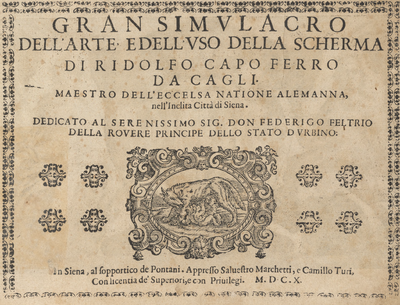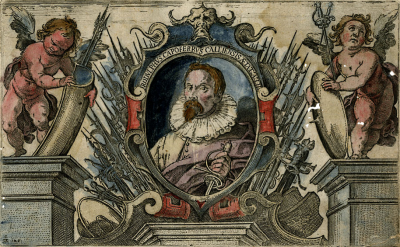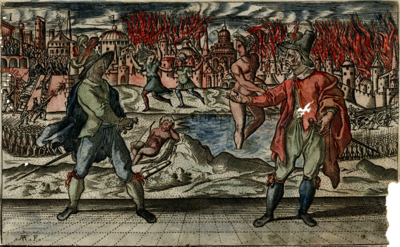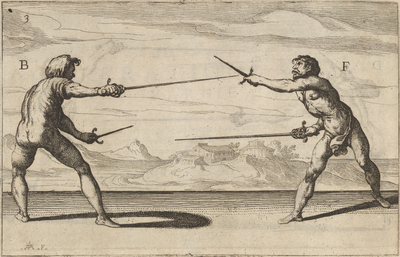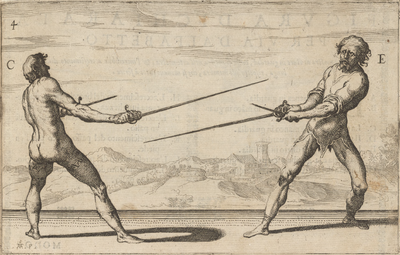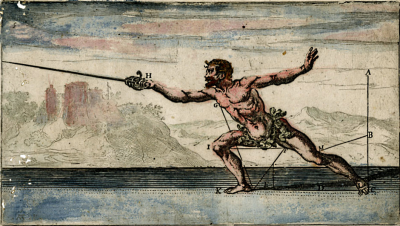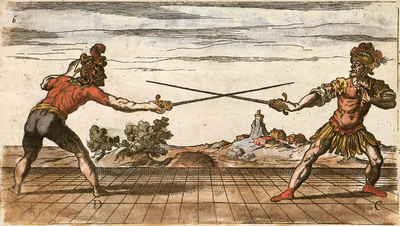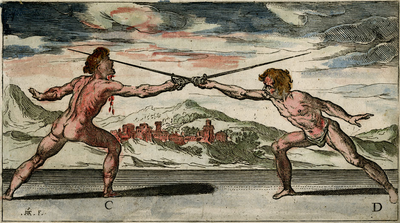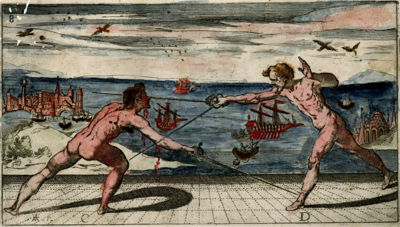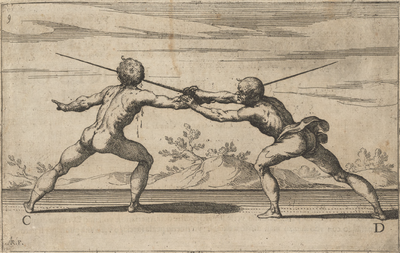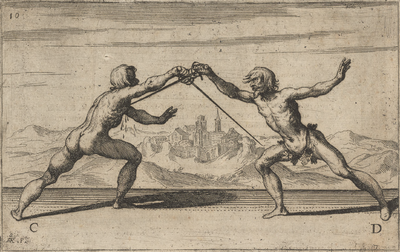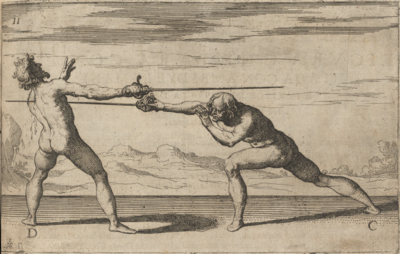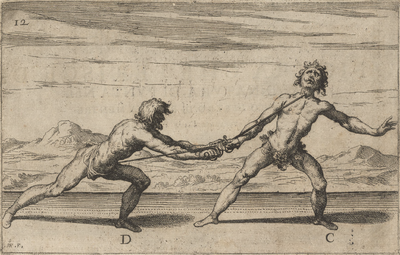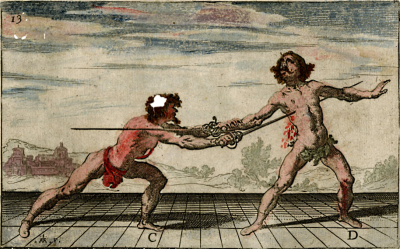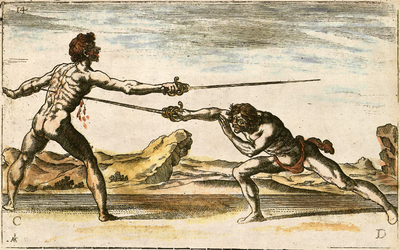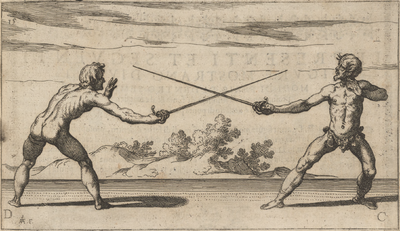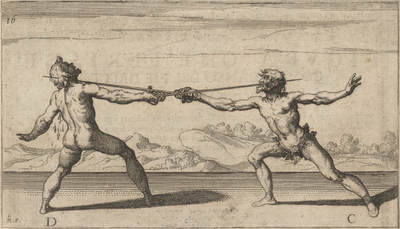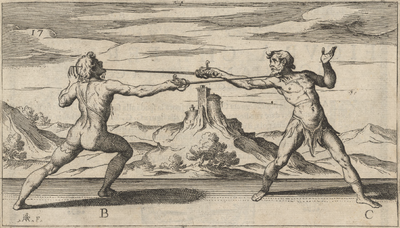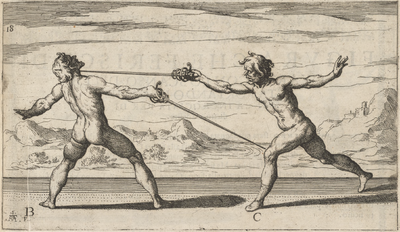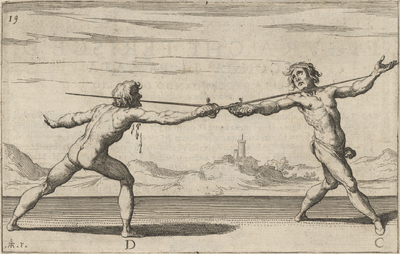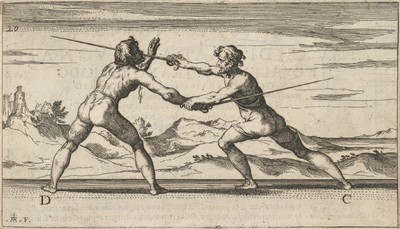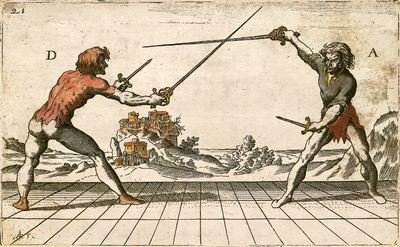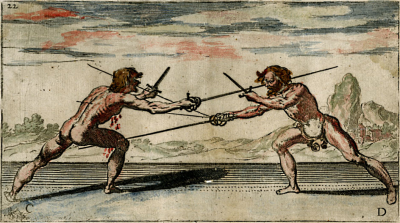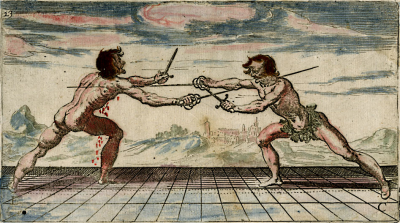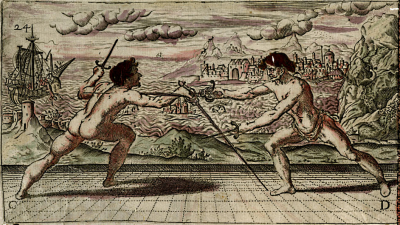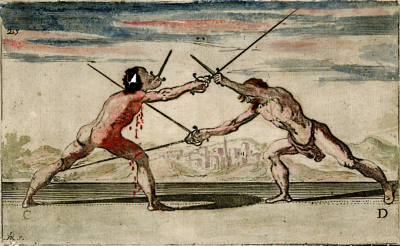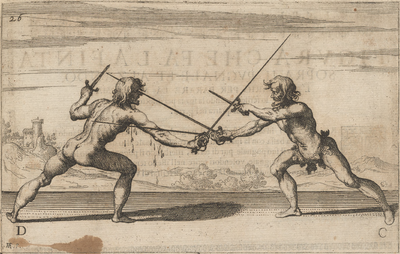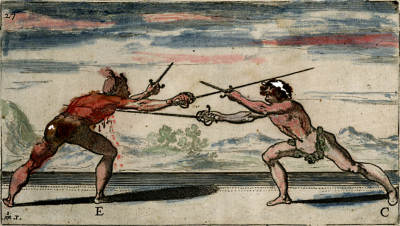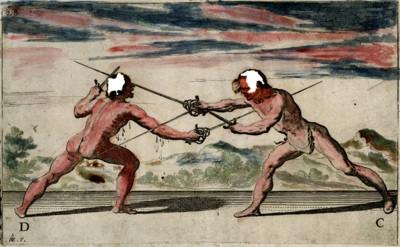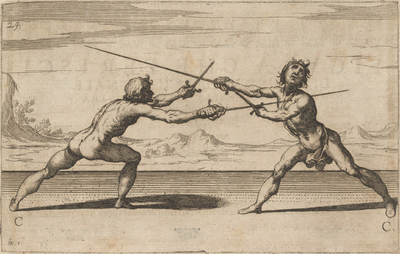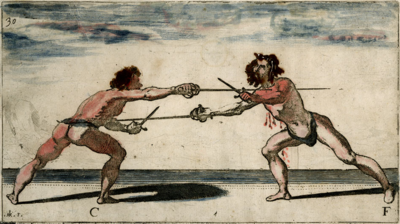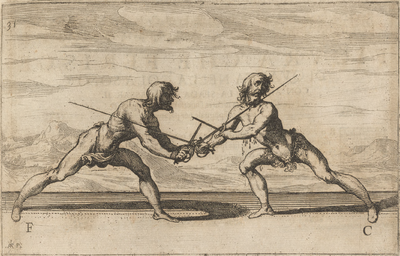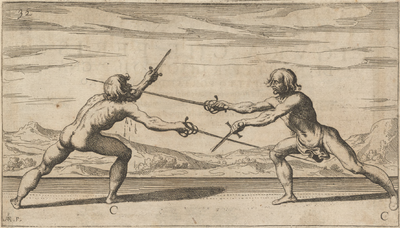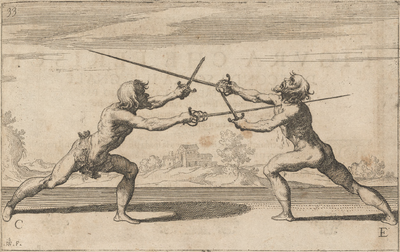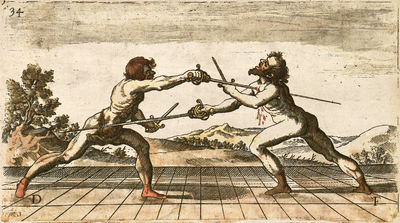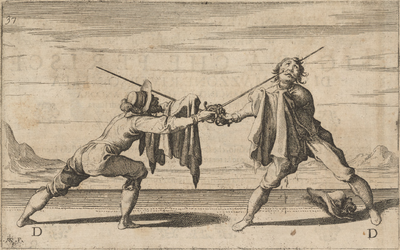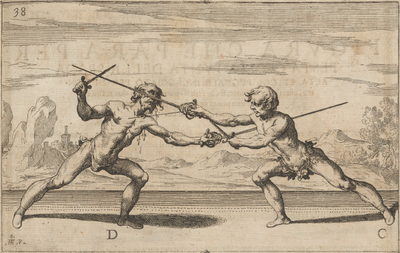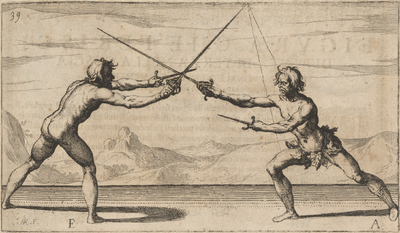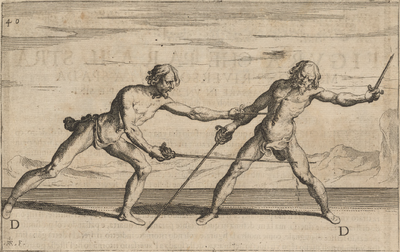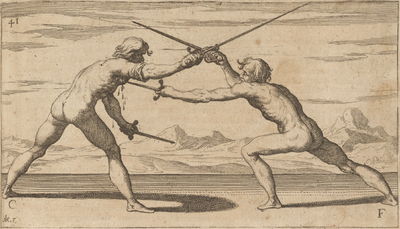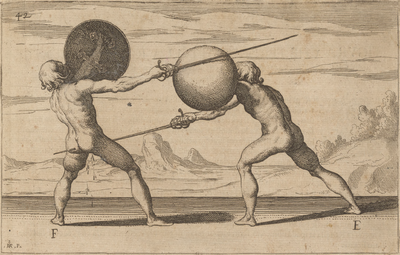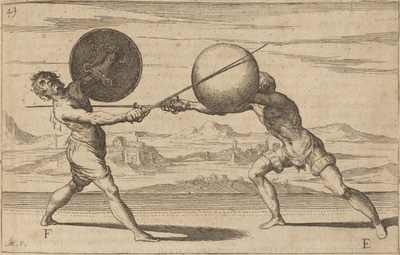|
|
You are not currently logged in. Are you accessing the unsecure (http) portal? Click here to switch to the secure portal. |
Difference between revisions of "Ridolfo Capo Ferro da Cagli"
| (5 intermediate revisions by the same user not shown) | |||
| Line 1,224: | Line 1,224: | ||
|- | |- | ||
| [[File:Capo Ferro 02.png|400x400px|center]] | | [[File:Capo Ferro 02.png|400x400px|center]] | ||
| − | |||
| − | + | [[File:Capo Ferro 03.png|400x400px|center]] | |
| − | |||
| − | | | ||
| − | + | [[File:Capo Ferro 04.png|400x400px|center]] | |
| − | + | | <p>[33] '''Of the Guards.'''</p> | |
| − | | | + | <p>Even as one cannot make some composition of beautiful and judicious writings without employing the letters of the alphabet, so does it occur in this, our art of fencing, that without the following guards, and some voids and retreats of the body which come to be the foundation of this practice, one could not in any way demonstrate this, our use; therefore the following six figures are designated alphabetically. “A” demonstrates ''prima'' to you, and ''seconda'' is presented to you as “B”, and ''terza'' as “C”. ''quarta'' is named as “D”, ''quinta'' as “E”, and ''sesta'' as “F”.<ref>Note that in the plates that follow, figures continue to be labeled as A through F, generally representing the starting position of each figure. ''quinta'' and ''sesta'' are not otherwise explained as ''prima'' through ''quarta'' were, but as judged by these plates and the occurrences of these two guards in the sections on dagger and rotella, they apparently describe guards involving an auxiliary arm, where the sword is low, usually in ''terza'' or less often in ''quarta'', while the left hand is held either low for ''quinta'', or high for ''sesta''.</ref></p> |
| − | | | + | | {{pagetb|Page:Gran Simulacro dell'Arte e dell'Uso della Scherma (Ridolfo Capo Ferro da Cagli) 1610.pdf|61|lbl=44}} |
| + | | | ||
|- | |- | ||
| Line 1,285: | Line 1,283: | ||
|- | |- | ||
| − | | [[File:Capo Ferro 1629 08 | + | | [[File:Capo Ferro 1629 08.png|400x400px|center]] |
| <p>[36] '''Figures that Demonstrate How Much Measure is Lost by Attacking the Legs.'''</p> | | <p>[36] '''Figures that Demonstrate How Much Measure is Lost by Attacking the Legs.'''</p> | ||
| Line 1,302: | Line 1,300: | ||
|- | |- | ||
| [[File:Capo Ferro 10.png|400x400px|center]] | | [[File:Capo Ferro 10.png|400x400px|center]] | ||
| − | | <p>[38] '''A Figure that Strikes in ''quarta'' Under the Right Arm to the Pectoral<ref>“Pectoral” i.e. “poccia”— properly, a breast or nipple. I use “pectoral” to distinguish between “a breast” (one side of the chest) and “the breast” (the chest in general), on the assumption that Capo Ferro is not being so specific as to recommend aiming precisely for the nipple.</ref> while the Adversary Disengages in Order to Strike.'''</p> | + | | <p>[38] '''A Figure that Strikes in ''quarta'' Under the Right Arm to the Pectoral<ref>“Pectoral” i.e. “poccia”— properly, a breast or nipple. I use “pectoral” to distinguish between “a breast” (one side of the chest) and “the breast” (the chest in general), on the assumption that Capo Ferro is not being so specific as to recommend aiming precisely for the nipple.</ref> while the Adversary Disengages in Order to Strike.'''<br/><br/></p> |
<p>The sword of the figure C being gained by the figure D, the same C turns a ''riverso'' to the face of the figure marked as D. D strikes him in ''quarta'' in the chest under the sword arm during the turning of the ''riverso'', raising his arm and the hilt of his sword well, increasing his pace well, as you see. However, I say that if C, instead of turning the ''riverso'', had drawn back his sword while retiring back somewhat, and lifted his sword in an oblique line so that its point faced toward the adversary's left side, and D had wanted to enter in ''quarta'', C, parrying with a mezzo ''mandritto'', would have given him a ''riverso'' to the face or a thrust to the chest.</p> | <p>The sword of the figure C being gained by the figure D, the same C turns a ''riverso'' to the face of the figure marked as D. D strikes him in ''quarta'' in the chest under the sword arm during the turning of the ''riverso'', raising his arm and the hilt of his sword well, increasing his pace well, as you see. However, I say that if C, instead of turning the ''riverso'', had drawn back his sword while retiring back somewhat, and lifted his sword in an oblique line so that its point faced toward the adversary's left side, and D had wanted to enter in ''quarta'', C, parrying with a mezzo ''mandritto'', would have given him a ''riverso'' to the face or a thrust to the chest.</p> | ||
| Line 1,321: | Line 1,319: | ||
<p>Figure D having gained the sword of the figure marked as C on the inside in low guard, and the said C disengaging to give a ''stoccata'' to the chest of figure D, D passes with the left leg and at the same time, pressing the enemy’s sword down with both hands, strikes him in the chest in ''terza''. But without any doubt, if C had been an intelligent person, when he disengaged the point to attack he would have disengaged somewhat retired, and D, parrying and passing with both hands to strike C, C only with a lowering of the point of the sword toward the earth and turning his hand to ''seconda'', somewhat voiding his body toward the left side of the adversary and disengaging the edge over the enemy's sword, will strike him on the inside with a ''riverso'' to the face, retiring into ''terza''; or having parried,<ref>This final maneuver is difficult to interpret; the subjects of the actions are not specified. It is possible that the meaning is that once D has parried, then C (being somewhat retired) may pass to the right with his left leg while holding his own sword in two hands, thereby turning his body somewhat and consequently freeing his sword out from under D’s, and then strike D in the chest.</ref> he will pass to the inside with the left leg; turning the body to the right, and holding his sword with both hands, while turning he will give him a thrust to the chest, going to him so that D cannot be saved.</p> | <p>Figure D having gained the sword of the figure marked as C on the inside in low guard, and the said C disengaging to give a ''stoccata'' to the chest of figure D, D passes with the left leg and at the same time, pressing the enemy’s sword down with both hands, strikes him in the chest in ''terza''. But without any doubt, if C had been an intelligent person, when he disengaged the point to attack he would have disengaged somewhat retired, and D, parrying and passing with both hands to strike C, C only with a lowering of the point of the sword toward the earth and turning his hand to ''seconda'', somewhat voiding his body toward the left side of the adversary and disengaging the edge over the enemy's sword, will strike him on the inside with a ''riverso'' to the face, retiring into ''terza''; or having parried,<ref>This final maneuver is difficult to interpret; the subjects of the actions are not specified. It is possible that the meaning is that once D has parried, then C (being somewhat retired) may pass to the right with his left leg while holding his own sword in two hands, thereby turning his body somewhat and consequently freeing his sword out from under D’s, and then strike D in the chest.</ref> he will pass to the inside with the left leg; turning the body to the right, and holding his sword with both hands, while turning he will give him a thrust to the chest, going to him so that D cannot be saved.</p> | ||
| − | | {{pagetb|Page:Gran Simulacro dell'Arte e dell'Uso della Scherma (Ridolfo Capo Ferro da Cagli) 1610.pdf|79|lbl= | + | | {{pagetb|Page:Gran Simulacro dell'Arte e dell'Uso della Scherma (Ridolfo Capo Ferro da Cagli) 1610.pdf|79|lbl=61a}} |
| | | | ||
| Line 1,329: | Line 1,327: | ||
<p>This manner of attack is called the ''scannatura'',<ref>“''Scannatura''”: literally, “butchering”.</ref> which is done in the following manner, the figure designated as C having the sword of the figure marked as D ''stringer''ed on the outside. The same figure D disengages a thrust at the face of C, and the same C, meeting the enemy’s sword on the outside,<ref>While it is not explicitly stated, C must disengage in some fashion in order to parry D’s attempted thrust to C’s face on the outside. It is likely that C disengages under to parry the high thrust with his own point high, then abandons the engagement by lowering his point in ''seconda'' to strike the flank. A less likely possibility given the order in which events are described is that he disengages over and parries outward and low by lowering his point in ''seconda'', essentially as a transport.</ref> lowering the point to ''seconda'', and passing with the left leg in one same ''tempo'' strikes him in the flank, lowering the hilt with the body and seizing his hand as you see.</p> | <p>This manner of attack is called the ''scannatura'',<ref>“''Scannatura''”: literally, “butchering”.</ref> which is done in the following manner, the figure designated as C having the sword of the figure marked as D ''stringer''ed on the outside. The same figure D disengages a thrust at the face of C, and the same C, meeting the enemy’s sword on the outside,<ref>While it is not explicitly stated, C must disengage in some fashion in order to parry D’s attempted thrust to C’s face on the outside. It is likely that C disengages under to parry the high thrust with his own point high, then abandons the engagement by lowering his point in ''seconda'' to strike the flank. A less likely possibility given the order in which events are described is that he disengages over and parries outward and low by lowering his point in ''seconda'', essentially as a transport.</ref> lowering the point to ''seconda'', and passing with the left leg in one same ''tempo'' strikes him in the flank, lowering the hilt with the body and seizing his hand as you see.</p> | ||
| − | | {{pagetb|Page:Gran Simulacro dell'Arte e dell'Uso della Scherma (Ridolfo Capo Ferro da Cagli) 1610.pdf|81|lbl= | + | | {{pagetb|Page:Gran Simulacro dell'Arte e dell'Uso della Scherma (Ridolfo Capo Ferro da Cagli) 1610.pdf|81|lbl=61c}} |
| | | | ||
| Line 1,337: | Line 1,335: | ||
<p>Figure D having gained the sword of the figure C on the inside, and the same figure C disengaging to give a ''stoccata'' to the face of figure D, D lowering his body and stepping forward with his right leg in one same ''tempo'' strikes him in ''seconda'' below the enemy's sword in contra ''tempo'' without parrying as the picture shows. And moreover he could succeed were the said thrust done differently, that is, that C disengaging to give a ''stoccata'' to figure D in the face, D parries in ''terza'' with the point high and in the same ''tempo'' lowering the point and turning the sword to ''seconda'' he could strike him in the chest with a ''passata'' while also giving him a grip on his sword hand. But if C was an experienced person he could have only withdrawn his right foot to the rear and in his<ref>“In his approach” refers to D’s approach with a ''passata''; C’s counter is to slip measure by withdrawing the leg, then execute the parry and ''scannatura'' described.</ref> approach, meeting the enemy's sword on the outside and in the same ''tempo'' lowering the point and turning the hand to ''seconda'' he would strike him with a ''scannatura'' below the enemy's sword; alternately, in his withdrawing, he will parry with his left hand from above downwards under his arm and will strike D with a high ''seconda'' to the chest or to the face.</p> | <p>Figure D having gained the sword of the figure C on the inside, and the same figure C disengaging to give a ''stoccata'' to the face of figure D, D lowering his body and stepping forward with his right leg in one same ''tempo'' strikes him in ''seconda'' below the enemy's sword in contra ''tempo'' without parrying as the picture shows. And moreover he could succeed were the said thrust done differently, that is, that C disengaging to give a ''stoccata'' to figure D in the face, D parries in ''terza'' with the point high and in the same ''tempo'' lowering the point and turning the sword to ''seconda'' he could strike him in the chest with a ''passata'' while also giving him a grip on his sword hand. But if C was an experienced person he could have only withdrawn his right foot to the rear and in his<ref>“In his approach” refers to D’s approach with a ''passata''; C’s counter is to slip measure by withdrawing the leg, then execute the parry and ''scannatura'' described.</ref> approach, meeting the enemy's sword on the outside and in the same ''tempo'' lowering the point and turning the hand to ''seconda'' he would strike him with a ''scannatura'' below the enemy's sword; alternately, in his withdrawing, he will parry with his left hand from above downwards under his arm and will strike D with a high ''seconda'' to the chest or to the face.</p> | ||
| − | | {{pagetb|Page:Gran Simulacro dell'Arte e dell'Uso della Scherma (Ridolfo Capo Ferro da Cagli) 1610.pdf|83|lbl= | + | | {{pagetb|Page:Gran Simulacro dell'Arte e dell'Uso della Scherma (Ridolfo Capo Ferro da Cagli) 1610.pdf|83|lbl=62}} |
| | | | ||
|- | |- | ||
| [[File:Capo Ferro 15.png|400x400px|center]] | | [[File:Capo Ferro 15.png|400x400px|center]] | ||
| − | | <p>[43] ''' | + | | <p>[43] '''Double Method of Gaining the Enemy's Sword on the Inside and the Outside.'''</p> |
| − | <p> | + | <p>Knowing through experience how useful it is to know how to gain the enemy's sword, I have not wanted to fail to describe the manner which one must adopt in going to ''stringer'' and gain the same, and first, wanting to go to ''stringer'' the adversary's sword, on the inside as on the outside, according to the occasion, you will first have to ''stringer'' the same at a distance of about one ''palmo'' from the point; if it occurs that you have to ''stringer'' on the inside, you will make the point of the sword aim at the adversary’s right shoulder; and if on the outside, at the left shoulder. Having done so, you will go walking towards the adversary’s sword; if it occurs that he disengages, in that instant you will counter-disengage with a return of your sword to its place, or with the same counter-disengage you will strike him in the ''tempo'' of his disengage. Moreover, if it occurs that the adversary approaches in order to ''stringer'' your sword, on the inside as well as the outside, which is lying level in the straight line with your arm extended, in that instant you will disengage and stringer, walking forward; and if it occurs that you have to disengage in order to ''stringer'' on the inside, you will carry your right foot forward during the disengage, bending your body toward your right side, holding your left hand near your right, and then passing with your left foot, you will strike him with a thrust in the breast in ''quarta''; and if you have to disengage in order to ''stringer'' on the outside, you will in a similar manner carry your right foot forward with a bending of your body to your left side, and passing with the left foot, strike the chest in ''seconda''. Moreover, be aware that the following figures demonstrate ''stringer''ing the sword on the outside in ''terza''; however you must follow the rule of gaining the sword of the adversary as stated above.</p> |
| − | | {{pagetb|Page:Gran Simulacro dell'Arte e dell'Uso della Scherma (Ridolfo Capo Ferro da Cagli) 1610.pdf|85|lbl= | + | | {{pagetb|Page:Gran Simulacro dell'Arte e dell'Uso della Scherma (Ridolfo Capo Ferro da Cagli) 1610.pdf|85|lbl=64}} |
| | | | ||
|- | |- | ||
| [[File:Capo Ferro 16.png|400x400px|center]] | | [[File:Capo Ferro 16.png|400x400px|center]] | ||
| − | | <p>[44] ''' | + | | <p>[44] '''The Present and Subsequent Figures Demonstrate Diverse Ways of Striking to the Inside, Always Presupposing a ''Stringer''ing on the Outside and a Disengagement of the Point by Your Adversary in Order to Strike.'''</p> |
| − | <p> | + | <p>The following figures demonstrate diverse ways of striking on the inside, always presupposing on your side a ''stringer''ing on the outside, and on that of your adversary, a disengage in order to strike you. D disengaging as above, C will strike him in ''quarta'' with a fixed foot, or with an increase of pace, in the throat or face. But if D had been an intelligent person, when he disengaged he would have disengaged with a beating of his enemy's sword with his edge, giving him a thrust to the face or a ''riverso'' to the arm of the figure designated as C, withdrawing into ''terza'' in ordinary pace.</p> |
| − | | {{pagetb|Page:Gran Simulacro dell'Arte e dell'Uso della Scherma (Ridolfo Capo Ferro da Cagli) 1610.pdf|87|lbl= | + | | {{pagetb|Page:Gran Simulacro dell'Arte e dell'Uso della Scherma (Ridolfo Capo Ferro da Cagli) 1610.pdf|87|lbl=66}} |
| | | | ||
| Line 1,361: | Line 1,359: | ||
<p>The figure designated as C having the figure marked as B ''stringer''ed on the outside, and this figure disengaging to strike the figure designated as C in ''quarta'', the same figure marked as C strikes him in the face near the ear outside of his sword with a void of the traversed right foot. I will never fail to say that if B had been an experienced person he would have disengaged the sword by way of a feint with his body held back somewhat to the rear, and C approaching confidently in order to strike figure B with the void of the traversed right foot, B, meeting the enemy's sword on the outside, lowering his point in ''seconda'' and passing with the left leg in one same ''tempo'', would strike him in the flank, giving him a grip to his sword hand.<ref>This final counter by B appears simply to be the ''scannatura'' once more.</ref></p> | <p>The figure designated as C having the figure marked as B ''stringer''ed on the outside, and this figure disengaging to strike the figure designated as C in ''quarta'', the same figure marked as C strikes him in the face near the ear outside of his sword with a void of the traversed right foot. I will never fail to say that if B had been an experienced person he would have disengaged the sword by way of a feint with his body held back somewhat to the rear, and C approaching confidently in order to strike figure B with the void of the traversed right foot, B, meeting the enemy's sword on the outside, lowering his point in ''seconda'' and passing with the left leg in one same ''tempo'', would strike him in the flank, giving him a grip to his sword hand.<ref>This final counter by B appears simply to be the ''scannatura'' once more.</ref></p> | ||
| − | | {{pagetb|Page:Gran Simulacro dell'Arte e dell'Uso della Scherma (Ridolfo Capo Ferro da Cagli) 1610.pdf|89|lbl= | + | | {{pagetb|Page:Gran Simulacro dell'Arte e dell'Uso della Scherma (Ridolfo Capo Ferro da Cagli) 1610.pdf|89|lbl=68}} |
| | | | ||
| Line 1,371: | Line 1,369: | ||
<p>But if B had been an experienced person he would have disengaged his sword by way of a feint, with his body held back somewhat to the rear, and C approaching confidently to pass with the ''quarta'', B executing an ''inquartata'' with a void of his body, passing with his left leg behind his right, would strike him in the chest.</p> | <p>But if B had been an experienced person he would have disengaged his sword by way of a feint, with his body held back somewhat to the rear, and C approaching confidently to pass with the ''quarta'', B executing an ''inquartata'' with a void of his body, passing with his left leg behind his right, would strike him in the chest.</p> | ||
| − | | {{pagetb|Page:Gran Simulacro dell'Arte e dell'Uso della Scherma (Ridolfo Capo Ferro da Cagli) 1610.pdf|91|lbl= | + | | {{pagetb|Page:Gran Simulacro dell'Arte e dell'Uso della Scherma (Ridolfo Capo Ferro da Cagli) 1610.pdf|91|lbl=69a}} |
| | | | ||
| Line 1,379: | Line 1,377: | ||
<p>The sword of figure D being gained on the outside by figure C, and D disengaging in order to give a thrust to the face of figure C, C strikes him in ''quarta'' with a void of the body, stepping with the left leg crossing behind the right as the figure demonstrates. But if D had been an experienced person he would have disengaged in order to gain the sword of figure C on the inside, with a bending of his body toward his right side, and having gained it, would have passed forward immediately with his left foot, giving him a thrust in ''quarta'' to the chest; alternately he would have disengaged with a mezzo ''mandritto'', beating the enemy's sword, giving C a ''riverso'' to the face, withdrawing into ''terza'', and thus he would have been secure.</p> | <p>The sword of figure D being gained on the outside by figure C, and D disengaging in order to give a thrust to the face of figure C, C strikes him in ''quarta'' with a void of the body, stepping with the left leg crossing behind the right as the figure demonstrates. But if D had been an experienced person he would have disengaged in order to gain the sword of figure C on the inside, with a bending of his body toward his right side, and having gained it, would have passed forward immediately with his left foot, giving him a thrust in ''quarta'' to the chest; alternately he would have disengaged with a mezzo ''mandritto'', beating the enemy's sword, giving C a ''riverso'' to the face, withdrawing into ''terza'', and thus he would have been secure.</p> | ||
| − | | {{pagetb|Page:Gran Simulacro dell'Arte e dell'Uso della Scherma (Ridolfo Capo Ferro da Cagli) 1610.pdf|93|lbl= | + | | {{pagetb|Page:Gran Simulacro dell'Arte e dell'Uso della Scherma (Ridolfo Capo Ferro da Cagli) 1610.pdf|93|lbl=70}} |
| | | | ||
| Line 1,387: | Line 1,385: | ||
<p>By clarification of the following figures, C, having his adversary, that is, the figure D, ''stringer''ed to the outside, and the same D disengaging to give a ''stoccata'' to figure C, the same C parries the enemy’s sword in ''quarta'' with a beat of the right foot, and all in one ''tempo'', passing and turning the body well, he will strike him in ''seconda'' in the face, although this can also be done without passing, striking him in ''quarta'' although in dui tempi.<ref>For clarification of the footwork accompanying primo ''tempo'' vis-à-vis dui tempi parries, see “Explanation of some terms of fencing” #7, “Of the parries”.</ref> But if D had been a person experienced in swordplay, when C disengaged to parry figure D in ''quarta''<ref>This passage presents some difficulty—C is not described as disengaging in the beginning of this plate, only as having parried in fourth (which would not require a disengage since D was described as having begun on the outside and then disengaged to attack). It is possible that the subsequent “counter-disengage” by D is D’s own return to outside ''stringimento'' following an initial disengage to the inside by way of a feint.</ref> with a beating of his right foot, D would have counter-disengaged his sword to the outside and would have struck him in the face in ''seconda'', withdrawing to the rear into ''terza'', following the enemy’s sword with his sword in said withdrawing, and thus would C be struck.</p> | <p>By clarification of the following figures, C, having his adversary, that is, the figure D, ''stringer''ed to the outside, and the same D disengaging to give a ''stoccata'' to figure C, the same C parries the enemy’s sword in ''quarta'' with a beat of the right foot, and all in one ''tempo'', passing and turning the body well, he will strike him in ''seconda'' in the face, although this can also be done without passing, striking him in ''quarta'' although in dui tempi.<ref>For clarification of the footwork accompanying primo ''tempo'' vis-à-vis dui tempi parries, see “Explanation of some terms of fencing” #7, “Of the parries”.</ref> But if D had been a person experienced in swordplay, when C disengaged to parry figure D in ''quarta''<ref>This passage presents some difficulty—C is not described as disengaging in the beginning of this plate, only as having parried in fourth (which would not require a disengage since D was described as having begun on the outside and then disengaged to attack). It is possible that the subsequent “counter-disengage” by D is D’s own return to outside ''stringimento'' following an initial disengage to the inside by way of a feint.</ref> with a beating of his right foot, D would have counter-disengaged his sword to the outside and would have struck him in the face in ''seconda'', withdrawing to the rear into ''terza'', following the enemy’s sword with his sword in said withdrawing, and thus would C be struck.</p> | ||
| − | | {{pagetb|Page:Gran Simulacro dell'Arte e dell'Uso della Scherma (Ridolfo Capo Ferro da Cagli) 1610.pdf|95|lbl= | + | | {{pagetb|Page:Gran Simulacro dell'Arte e dell'Uso della Scherma (Ridolfo Capo Ferro da Cagli) 1610.pdf|95|lbl=72}} |
| | | | ||
| Line 1,395: | Line 1,393: | ||
<p>The following figures demonstrate the play of sword and dagger, and principally is taught the manner of ''stringer''ing the sword of the adversary, he being found in a high ''prima'', noting that it is not possible in one figure to demonstrate all of the manners of ''stringer''ing on the outside and on the inside, from low and from high, deferring in this to the discretion of the reader, noting only that if the point of the enemy's sword is aimed towards your right side you will find him on the outside, and moreover that if it occurs to you to ''stringer'' the low guards, you will ''stringer'' with the sword in the sloping line,<ref>“Sloping line” i.e. “linea pendiculare”—a downwardly angled, that is hanging or sloping line. Thus when the adversary’s sword is high, one must point one’s sword upwards, and similarly when the adversary’s sword is low, one must point one’s sword downwards in order to ''stringer'' it. In these cases it is apparently necessary to depart from the straight line in order to ''stringer''.</ref> with the ''terza'' as with the ''quarta''.</p> | <p>The following figures demonstrate the play of sword and dagger, and principally is taught the manner of ''stringer''ing the sword of the adversary, he being found in a high ''prima'', noting that it is not possible in one figure to demonstrate all of the manners of ''stringer''ing on the outside and on the inside, from low and from high, deferring in this to the discretion of the reader, noting only that if the point of the enemy's sword is aimed towards your right side you will find him on the outside, and moreover that if it occurs to you to ''stringer'' the low guards, you will ''stringer'' with the sword in the sloping line,<ref>“Sloping line” i.e. “linea pendiculare”—a downwardly angled, that is hanging or sloping line. Thus when the adversary’s sword is high, one must point one’s sword upwards, and similarly when the adversary’s sword is low, one must point one’s sword downwards in order to ''stringer'' it. In these cases it is apparently necessary to depart from the straight line in order to ''stringer''.</ref> with the ''terza'' as with the ''quarta''.</p> | ||
| − | | {{pagetb|Page:Gran Simulacro dell'Arte e dell'Uso della Scherma (Ridolfo Capo Ferro da Cagli) 1610.pdf|97|lbl= | + | | {{pagetb|Page:Gran Simulacro dell'Arte e dell'Uso della Scherma (Ridolfo Capo Ferro da Cagli) 1610.pdf|97|lbl=74}} |
| | | | ||
| Line 1,403: | Line 1,401: | ||
<p>These following figures demonstrate an artful manner of striking in three different ways with a thrust with a single parry of the dagger, which are done thus: that, in ''quarta'', having the adversary ''stringer''ed on the inside in whatsoever guard apt for ''stringer''ing on the inside, he will be able to disengage to give you a thrust in two ways: to the face or chest; however, he having disengaged to strike you, you will parry his sword to the inside with your dagger over your right arm, and in the first occasion you will be able to strike him high or low, that is, to the face, or under the arm in the chest or in the thigh; and in the second only to the face or thigh.</p> | <p>These following figures demonstrate an artful manner of striking in three different ways with a thrust with a single parry of the dagger, which are done thus: that, in ''quarta'', having the adversary ''stringer''ed on the inside in whatsoever guard apt for ''stringer''ing on the inside, he will be able to disengage to give you a thrust in two ways: to the face or chest; however, he having disengaged to strike you, you will parry his sword to the inside with your dagger over your right arm, and in the first occasion you will be able to strike him high or low, that is, to the face, or under the arm in the chest or in the thigh; and in the second only to the face or thigh.</p> | ||
| − | | {{pagetb|Page:Gran Simulacro dell'Arte e dell'Uso della Scherma (Ridolfo Capo Ferro da Cagli) 1610.pdf|99|lbl= | + | | {{pagetb|Page:Gran Simulacro dell'Arte e dell'Uso della Scherma (Ridolfo Capo Ferro da Cagli) 1610.pdf|99|lbl=76}} |
| | | | ||
| Line 1,411: | Line 1,409: | ||
<p>The adversary lying in a low ''terza'' with the arm withdrawn, and with the dagger forward and united with the sword, you will place yourself opposite him in a high ''terza'', making a feint outside of the dagger to the face in a high ''quarta'' or a similar ''terza'', and while he raises his dagger to parry and attack you in ''quarta'', you will disengage over his dagger and, in the same ''tempo'', parrying to the inside you will strike him in ''seconda'' in the chest.</p> | <p>The adversary lying in a low ''terza'' with the arm withdrawn, and with the dagger forward and united with the sword, you will place yourself opposite him in a high ''terza'', making a feint outside of the dagger to the face in a high ''quarta'' or a similar ''terza'', and while he raises his dagger to parry and attack you in ''quarta'', you will disengage over his dagger and, in the same ''tempo'', parrying to the inside you will strike him in ''seconda'' in the chest.</p> | ||
| − | | {{pagetb|Page:Gran Simulacro dell'Arte e dell'Uso della Scherma (Ridolfo Capo Ferro da Cagli) 1610.pdf|101|lbl= | + | | {{pagetb|Page:Gran Simulacro dell'Arte e dell'Uso della Scherma (Ridolfo Capo Ferro da Cagli) 1610.pdf|101|lbl=78}} |
| | | | ||
| Line 1,419: | Line 1,417: | ||
<p>From this figure you will easily be able to comprehend and learn the manner of casting down the sword from the hand and giving as well in the same ''tempo'' a thrust to the chest; that is, finding yourself in ''terza'' with your arm withdrawn and uniting your dagger with your sword, the adversary being in the same guard, or in ''quarta'', you will commence to ''stringer'' his sword on the inside in ''quarta'', and you will lower your dagger to the middle of your right arm in an oblique line; and your adversary disengaging to strike you in the chest in ''quarta'', you will strike him from the outside with a ''punta riversa'' to the body, raising the hilt of your sword somewhat and in the same ''tempo'' parrying downward with the flat of your dagger to the outside you will force him to abandon his weapon.<ref>In practice, actually disarming the enemy has proven difficult unless some forward motion (toward the opponent) with the flat of the dagger accompanies the parry to the outside.</ref></p> | <p>From this figure you will easily be able to comprehend and learn the manner of casting down the sword from the hand and giving as well in the same ''tempo'' a thrust to the chest; that is, finding yourself in ''terza'' with your arm withdrawn and uniting your dagger with your sword, the adversary being in the same guard, or in ''quarta'', you will commence to ''stringer'' his sword on the inside in ''quarta'', and you will lower your dagger to the middle of your right arm in an oblique line; and your adversary disengaging to strike you in the chest in ''quarta'', you will strike him from the outside with a ''punta riversa'' to the body, raising the hilt of your sword somewhat and in the same ''tempo'' parrying downward with the flat of your dagger to the outside you will force him to abandon his weapon.<ref>In practice, actually disarming the enemy has proven difficult unless some forward motion (toward the opponent) with the flat of the dagger accompanies the parry to the outside.</ref></p> | ||
| − | | {{pagetb|Page:Gran Simulacro dell'Arte e dell'Uso della Scherma (Ridolfo Capo Ferro da Cagli) 1610.pdf|103|lbl= | + | | {{pagetb|Page:Gran Simulacro dell'Arte e dell'Uso della Scherma (Ridolfo Capo Ferro da Cagli) 1610.pdf|103|lbl=80}} |
| | | | ||
| Line 1,427: | Line 1,425: | ||
<p>Finding yourself in ''quarta'' with the dagger high and your adversary in whatsoever guard apt for ''stringer''ing on the inside, with the right leg forward, you will commence to ''stringer'' him on the inside in ''quarta'', and he disengaging to strike you in the face in ''quarta'', you, parrying to the inside with your dagger, over your right arm, will be able to strike him either with a ''riverso'' to the thigh or with a ''quarta'' below the arm.</p> | <p>Finding yourself in ''quarta'' with the dagger high and your adversary in whatsoever guard apt for ''stringer''ing on the inside, with the right leg forward, you will commence to ''stringer'' him on the inside in ''quarta'', and he disengaging to strike you in the face in ''quarta'', you, parrying to the inside with your dagger, over your right arm, will be able to strike him either with a ''riverso'' to the thigh or with a ''quarta'' below the arm.</p> | ||
| − | | {{pagetb|Page:Gran Simulacro dell'Arte e dell'Uso della Scherma (Ridolfo Capo Ferro da Cagli) 1610.pdf|105|lbl= | + | | {{pagetb|Page:Gran Simulacro dell'Arte e dell'Uso della Scherma (Ridolfo Capo Ferro da Cagli) 1610.pdf|105|lbl=82}} |
| | | | ||
|- | |- | ||
| − | | [[File:Capo Ferro | + | | [[File:Capo Ferro 26.png|400x400px|center]] |
| <p>[54] '''A Figure that Parries with the Sword in ''Quarta'' Accompanied with the Dagger and Strikes in ''Quarta'' to the Face or with a ''Riverso'' to the Arm as the Figure Shows.'''</p> | | <p>[54] '''A Figure that Parries with the Sword in ''Quarta'' Accompanied with the Dagger and Strikes in ''Quarta'' to the Face or with a ''Riverso'' to the Arm as the Figure Shows.'''</p> | ||
<p>If it so happens that you find yourself in an extended ''terza'' with the dagger at your wrist, your adversary being in whatsoever guard apt for ''stringer''ing on the outside, you will commence to ''stringer'' him with the same ''terza'', now high, now low, according to the occasion, however without moving the dagger from its place, and your adversary disengaging to strike you in ''quarta'' or ''seconda'', parrying in ''quarta'' with your sword accompanied with your dagger you will be able to strike him, as you see, either with a ''riverso'' to the arm or a ''quarta'' to the face.</p> | <p>If it so happens that you find yourself in an extended ''terza'' with the dagger at your wrist, your adversary being in whatsoever guard apt for ''stringer''ing on the outside, you will commence to ''stringer'' him with the same ''terza'', now high, now low, according to the occasion, however without moving the dagger from its place, and your adversary disengaging to strike you in ''quarta'' or ''seconda'', parrying in ''quarta'' with your sword accompanied with your dagger you will be able to strike him, as you see, either with a ''riverso'' to the arm or a ''quarta'' to the face.</p> | ||
| − | | {{pagetb|Page:Gran Simulacro dell'Arte e dell'Uso della Scherma (Ridolfo Capo Ferro da Cagli) 1610.pdf|107|lbl= | + | | {{pagetb|Page:Gran Simulacro dell'Arte e dell'Uso della Scherma (Ridolfo Capo Ferro da Cagli) 1610.pdf|107|lbl=84}} |
| | | | ||
| Line 1,443: | Line 1,441: | ||
<p>Finding yourself in an extended ''terza'' with the dagger at the wrist, and the adversary being in a low ''Quarta'' with his sword withdrawn and his dagger high and extended, you will commence to make a feint above his dagger in ''terza''; maintaining your dagger in its place, he parrying upwards with his dagger, wanting to strike you in the same ''tempo'' in ''Quarta'' or ''Seconda'', you will disengage under, and parrying his attack therewith<ref>“Parrying his attack therewith” i.e. at the same time. Note that the picture shows the parry being accomplished with the dagger.</ref> you will strike him in ''Quarta'' in the chest.</p> | <p>Finding yourself in an extended ''terza'' with the dagger at the wrist, and the adversary being in a low ''Quarta'' with his sword withdrawn and his dagger high and extended, you will commence to make a feint above his dagger in ''terza''; maintaining your dagger in its place, he parrying upwards with his dagger, wanting to strike you in the same ''tempo'' in ''Quarta'' or ''Seconda'', you will disengage under, and parrying his attack therewith<ref>“Parrying his attack therewith” i.e. at the same time. Note that the picture shows the parry being accomplished with the dagger.</ref> you will strike him in ''Quarta'' in the chest.</p> | ||
| − | | {{pagetb|Page:Gran Simulacro dell'Arte e dell'Uso della Scherma (Ridolfo Capo Ferro da Cagli) 1610.pdf|109|lbl= | + | | {{pagetb|Page:Gran Simulacro dell'Arte e dell'Uso della Scherma (Ridolfo Capo Ferro da Cagli) 1610.pdf|109|lbl=86}} |
| | | | ||
|- | |- | ||
| − | | [[File:Capo Ferro 28.png|400x400px|center]] | + | | [[File:Capo Ferro 1629 28.png|400x400px|center]] |
| <p>[56] '''Figure that Parries Under His Right Arm with the Dagger, and Strikes in ''Seconda'' into the Face or with a ''Stramazzone Riverso'' in the Sword Arm.'''</p> | | <p>[56] '''Figure that Parries Under His Right Arm with the Dagger, and Strikes in ''Seconda'' into the Face or with a ''Stramazzone Riverso'' in the Sword Arm.'''</p> | ||
<p>Lying in a low or high ''terza'', with your dagger at your wrist, your adversary being in whatsoever guard convenient to ''stringer'' on the outside, you will begin to ''stringer'' on the outside in high or low ''terza'', according to the occasion, elevating your dagger, and he wanting to disengage to the inside, and throw in ''quarta'' or ''seconda'', you, parrying down with the dagger under your sword arm, will throw at him a ''stramazzone'' to his arm or you will strike him in ''seconda'' in the face, as is shown.</p> | <p>Lying in a low or high ''terza'', with your dagger at your wrist, your adversary being in whatsoever guard convenient to ''stringer'' on the outside, you will begin to ''stringer'' on the outside in high or low ''terza'', according to the occasion, elevating your dagger, and he wanting to disengage to the inside, and throw in ''quarta'' or ''seconda'', you, parrying down with the dagger under your sword arm, will throw at him a ''stramazzone'' to his arm or you will strike him in ''seconda'' in the face, as is shown.</p> | ||
| − | | {{pagetb|Page:Gran Simulacro dell'Arte e dell'Uso della Scherma (Ridolfo Capo Ferro da Cagli) 1610.pdf|111|lbl= | + | | {{pagetb|Page:Gran Simulacro dell'Arte e dell'Uso della Scherma (Ridolfo Capo Ferro da Cagli) 1610.pdf|111|lbl=88}} |
| | | | ||
| Line 1,459: | Line 1,457: | ||
<p>If you lie in extended ''terza'' with your dagger in an oblique line over the beginning of the ''forte'' of your sword, your adversary being in the same guard, he coming to ''stringer'' on the outside also in ''terza'', you will disengage and beat his sword with yours in ''quarta'' all in one ''tempo'', and immediately parrying his already pressed sword with your dagger, you will strike him in the same ''tempo'' over his dagger in the left shoulder.</p> | <p>If you lie in extended ''terza'' with your dagger in an oblique line over the beginning of the ''forte'' of your sword, your adversary being in the same guard, he coming to ''stringer'' on the outside also in ''terza'', you will disengage and beat his sword with yours in ''quarta'' all in one ''tempo'', and immediately parrying his already pressed sword with your dagger, you will strike him in the same ''tempo'' over his dagger in the left shoulder.</p> | ||
| − | | {{pagetb|Page:Gran Simulacro dell'Arte e dell'Uso della Scherma (Ridolfo Capo Ferro da Cagli) 1610.pdf|113|lbl= | + | | {{pagetb|Page:Gran Simulacro dell'Arte e dell'Uso della Scherma (Ridolfo Capo Ferro da Cagli) 1610.pdf|113|lbl=90}} |
| | | | ||
| Line 1,467: | Line 1,465: | ||
<p>You being in ''terza'' or ''quarta'' with your arm withdrawn, with your dagger at your wrist, your adversary being in ''quarta'' with his sword withdrawn and dagger high and extended, you will make a feint at him from under his dagger, raising yours, and he parrying down with his dagger toward his left side, you will disengage in the same ''tempo'' over his dagger, parrying the enemy’s sword to the inside under your right arm, and you will strike him in ''seconda'' over his dagger.</p> | <p>You being in ''terza'' or ''quarta'' with your arm withdrawn, with your dagger at your wrist, your adversary being in ''quarta'' with his sword withdrawn and dagger high and extended, you will make a feint at him from under his dagger, raising yours, and he parrying down with his dagger toward his left side, you will disengage in the same ''tempo'' over his dagger, parrying the enemy’s sword to the inside under your right arm, and you will strike him in ''seconda'' over his dagger.</p> | ||
| − | | {{pagetb|Page:Gran Simulacro dell'Arte e dell'Uso della Scherma (Ridolfo Capo Ferro da Cagli) 1610.pdf|115|lbl= | + | | {{pagetb|Page:Gran Simulacro dell'Arte e dell'Uso della Scherma (Ridolfo Capo Ferro da Cagli) 1610.pdf|115|lbl=92}} |
| | | | ||
| Line 1,475: | Line 1,473: | ||
<p>The adversary lying in ''terza'' with both weapons extended in an oblique line, so that the point of the enemy’s sword is aimed at your right shoulder and that of his dagger at your left, you will put yourself opposite him in ''terza'' with the point of your sword low and with your dagger high, with your body bent as much as possible toward your left side; and he wanting to approach in order to ''stringer'' you, or for some other aim of his, you will pass with your left foot in the same ''tempo'' toward his right side, and parrying with your dagger toward the inside over your right arm you will extend to him a thrust in falso from beneath upwards between his weapons, or alternately, disengaging over with the sword you will press his sword with both weapons, striking him in ''terza'' in the very same ''tempo''.</p> | <p>The adversary lying in ''terza'' with both weapons extended in an oblique line, so that the point of the enemy’s sword is aimed at your right shoulder and that of his dagger at your left, you will put yourself opposite him in ''terza'' with the point of your sword low and with your dagger high, with your body bent as much as possible toward your left side; and he wanting to approach in order to ''stringer'' you, or for some other aim of his, you will pass with your left foot in the same ''tempo'' toward his right side, and parrying with your dagger toward the inside over your right arm you will extend to him a thrust in falso from beneath upwards between his weapons, or alternately, disengaging over with the sword you will press his sword with both weapons, striking him in ''terza'' in the very same ''tempo''.</p> | ||
| − | | {{pagetb|Page:Gran Simulacro dell'Arte e dell'Uso della Scherma (Ridolfo Capo Ferro da Cagli) 1610.pdf|117|lbl= | + | | {{pagetb|Page:Gran Simulacro dell'Arte e dell'Uso della Scherma (Ridolfo Capo Ferro da Cagli) 1610.pdf|117|lbl=94}} |
| | | | ||
| Line 1,483: | Line 1,481: | ||
<p>The adversary lying in high ''terza'' with his dagger crossed and joined at the beginning of the ''forte'' of his sword, somewhat oblique, you will ''stringer'' it in ''terza'' on the outside, with the dagger high, and he disengaging under, assisting himself by parrying with his dagger in order to strike you in ''quarta'', you will parry with your dagger from high downwards, toward your left side, and in one ''tempo'' disengaging under his dagger, you will strike him in ''quarta'' in the face, or wherever it happens to be more convenient.</p> | <p>The adversary lying in high ''terza'' with his dagger crossed and joined at the beginning of the ''forte'' of his sword, somewhat oblique, you will ''stringer'' it in ''terza'' on the outside, with the dagger high, and he disengaging under, assisting himself by parrying with his dagger in order to strike you in ''quarta'', you will parry with your dagger from high downwards, toward your left side, and in one ''tempo'' disengaging under his dagger, you will strike him in ''quarta'' in the face, or wherever it happens to be more convenient.</p> | ||
| − | | {{pagetb|Page:Gran Simulacro dell'Arte e dell'Uso della Scherma (Ridolfo Capo Ferro da Cagli) 1610.pdf|119|lbl= | + | | {{pagetb|Page:Gran Simulacro dell'Arte e dell'Uso della Scherma (Ridolfo Capo Ferro da Cagli) 1610.pdf|119|lbl=96}} |
| | | | ||
| Line 1,491: | Line 1,489: | ||
<p>The adversary lying in low ''terza'', you will place yourself opposite him in high ''terza'' with your dagger joined crossed over your ''forte'', and he approaching by a ''passata'' to strike you in ''seconda'' over your dagger, and parrying wide with his, you only drawing back your right leg, and he raising his dagger to parry, you will disengage under his, carrying your body well forward, as the figure shows, and you will strike him in ''quarta''.</p> | <p>The adversary lying in low ''terza'', you will place yourself opposite him in high ''terza'' with your dagger joined crossed over your ''forte'', and he approaching by a ''passata'' to strike you in ''seconda'' over your dagger, and parrying wide with his, you only drawing back your right leg, and he raising his dagger to parry, you will disengage under his, carrying your body well forward, as the figure shows, and you will strike him in ''quarta''.</p> | ||
| − | | {{pagetb|Page:Gran Simulacro dell'Arte e dell'Uso della Scherma (Ridolfo Capo Ferro da Cagli) 1610.pdf|121|lbl= | + | | {{pagetb|Page:Gran Simulacro dell'Arte e dell'Uso della Scherma (Ridolfo Capo Ferro da Cagli) 1610.pdf|121|lbl=98}} |
| | | | ||
| Line 1,499: | Line 1,497: | ||
<p>Although the adversary lies in ''quarta'' with his sword withdrawn and low, and with his dagger extended high and wide, you will put yourself opposite him in ''quarta'' with your arm extended and dagger high, and he moving by a ''passata'' to parry your sword downward from high in order to strike you in ''seconda'', drawing your right leg back, you will parry him downward with your dagger toward your right side, and you will disengage your sword over his dagger, and will strike him in ''seconda''.</p> | <p>Although the adversary lies in ''quarta'' with his sword withdrawn and low, and with his dagger extended high and wide, you will put yourself opposite him in ''quarta'' with your arm extended and dagger high, and he moving by a ''passata'' to parry your sword downward from high in order to strike you in ''seconda'', drawing your right leg back, you will parry him downward with your dagger toward your right side, and you will disengage your sword over his dagger, and will strike him in ''seconda''.</p> | ||
| − | | {{pagetb|Page:Gran Simulacro dell'Arte e dell'Uso della Scherma (Ridolfo Capo Ferro da Cagli) 1610.pdf|123|lbl= | + | | {{pagetb|Page:Gran Simulacro dell'Arte e dell'Uso della Scherma (Ridolfo Capo Ferro da Cagli) 1610.pdf|123|lbl=100}} |
| | | | ||
| Line 1,507: | Line 1,505: | ||
<p>The adversary lying in ''quarta'' with his arm withdrawn, and with his dagger straight high and wide and with his arm extended, you will oppose him in extended ''terza'' with your dagger crossed in front of your breast, and you will approach his dagger from the outside, he still remaining in his guard; and once arrived, you will make the point of your sword even with his dagger, and will disengage over in ''quarta'', delivering to him a long ''stoccata'' into his chest.</p> | <p>The adversary lying in ''quarta'' with his arm withdrawn, and with his dagger straight high and wide and with his arm extended, you will oppose him in extended ''terza'' with your dagger crossed in front of your breast, and you will approach his dagger from the outside, he still remaining in his guard; and once arrived, you will make the point of your sword even with his dagger, and will disengage over in ''quarta'', delivering to him a long ''stoccata'' into his chest.</p> | ||
| − | | {{pagetb|Page:Gran Simulacro dell'Arte e dell'Uso della Scherma (Ridolfo Capo Ferro da Cagli) 1610.pdf|125|lbl= | + | | {{pagetb|Page:Gran Simulacro dell'Arte e dell'Uso della Scherma (Ridolfo Capo Ferro da Cagli) 1610.pdf|125|lbl=102}} |
| | | | ||
| Line 1,515: | Line 1,513: | ||
<p>To the end that this matter of the cape be better understood, it will perhaps not be out of place to explain some terms that must be used therewith. I tell you therefore that having the cape thereabout, it will be allowed to fall down off the right shoulder, to as far as the middle of the left arm, and then wrapping the left hand to the outside, enveloping the arm in the said cape, putting oneself with it into ''terza'', or in some other guard as you like. So much, then, when stepping, will that order be obtained as is held with the sword and dagger, as to be an identical progress, except that in parrying there is a difference. In that then, the cape can be cut, and punctured, which cannot occur to the dagger. And finding yourself in ''terza'', as above, at the encounter with your adversary, and he throws a ''mandritto'' at your head, you at the same time will step forward with your left foot, parrying against the ''forte'' of the enemy’s sword with your cape, extending to him a thrust into his chest; one can also parry the said blow in ''prima'' with the sword in guardia di testa<ref>In guardia di testa (“head guard”), the sword is held high with the point forward and somewhat to the left, hand usually in ''seconda''. See [[Antonio Manciolino|Manciolino]] pg. [[Page:Opera Nova (Antonio Manciolino) 1531.pdf/24|7 verso]], or [[Achille Marozzo|Marozzo]] Ch. [[Page:Opera Nova (Achille Marozzo) 1536.pdf/106|143]], which includes illustration.</ref> accompanied by the cape, gathering in that ''tempo'' your left foot near to your right, and immediately advance with the right, and turn a ''mandritto'' to his head or leg; but when he throws either a ''mandritto'' or ''riverso'' to your leg, you will draw back your right foot somewhat, and if it be a ''mandritto'', then give him a ''riverso'' to his sword arm; and if it be a ''riverso'', then give him a ''dritto'' likewise in the said arm; but the true parry will be to parry with the sword and then in the striking to go to accompany the sword with the cape, therewith hitting the enemy’s sword, and thus one will strike safely. Moreover I say that the following figures show the manner that one must employ to gain the sword of the adversary on the inside with sword and cape.</p> | <p>To the end that this matter of the cape be better understood, it will perhaps not be out of place to explain some terms that must be used therewith. I tell you therefore that having the cape thereabout, it will be allowed to fall down off the right shoulder, to as far as the middle of the left arm, and then wrapping the left hand to the outside, enveloping the arm in the said cape, putting oneself with it into ''terza'', or in some other guard as you like. So much, then, when stepping, will that order be obtained as is held with the sword and dagger, as to be an identical progress, except that in parrying there is a difference. In that then, the cape can be cut, and punctured, which cannot occur to the dagger. And finding yourself in ''terza'', as above, at the encounter with your adversary, and he throws a ''mandritto'' at your head, you at the same time will step forward with your left foot, parrying against the ''forte'' of the enemy’s sword with your cape, extending to him a thrust into his chest; one can also parry the said blow in ''prima'' with the sword in guardia di testa<ref>In guardia di testa (“head guard”), the sword is held high with the point forward and somewhat to the left, hand usually in ''seconda''. See [[Antonio Manciolino|Manciolino]] pg. [[Page:Opera Nova (Antonio Manciolino) 1531.pdf/24|7 verso]], or [[Achille Marozzo|Marozzo]] Ch. [[Page:Opera Nova (Achille Marozzo) 1536.pdf/106|143]], which includes illustration.</ref> accompanied by the cape, gathering in that ''tempo'' your left foot near to your right, and immediately advance with the right, and turn a ''mandritto'' to his head or leg; but when he throws either a ''mandritto'' or ''riverso'' to your leg, you will draw back your right foot somewhat, and if it be a ''mandritto'', then give him a ''riverso'' to his sword arm; and if it be a ''riverso'', then give him a ''dritto'' likewise in the said arm; but the true parry will be to parry with the sword and then in the striking to go to accompany the sword with the cape, therewith hitting the enemy’s sword, and thus one will strike safely. Moreover I say that the following figures show the manner that one must employ to gain the sword of the adversary on the inside with sword and cape.</p> | ||
| − | | {{pagetb|Page:Gran Simulacro dell'Arte e dell'Uso della Scherma (Ridolfo Capo Ferro da Cagli) 1610.pdf|127|lbl= | + | | {{pagetb|Page:Gran Simulacro dell'Arte e dell'Uso della Scherma (Ridolfo Capo Ferro da Cagli) 1610.pdf|127|lbl=104}} |
| | | | ||
| Line 1,523: | Line 1,521: | ||
<p>Your adversary being in ''quarta'' with his sword extended and high, you will commit yourself to ''stringer'' it in ''quarta'' on the inside, with your cape arm under your ''forte''; he wanting to disengage in order to strike you with a thrust in whatsoever manner, parrying upwards with your cape, to the outside of your left side, and counter-disengaging in ''quarta'', you will strike him in the face or wherever it will happen to be more convenient for you.</p> | <p>Your adversary being in ''quarta'' with his sword extended and high, you will commit yourself to ''stringer'' it in ''quarta'' on the inside, with your cape arm under your ''forte''; he wanting to disengage in order to strike you with a thrust in whatsoever manner, parrying upwards with your cape, to the outside of your left side, and counter-disengaging in ''quarta'', you will strike him in the face or wherever it will happen to be more convenient for you.</p> | ||
| − | | {{pagetb|Page:Gran Simulacro dell'Arte e dell'Uso della Scherma (Ridolfo Capo Ferro da Cagli) 1610.pdf|129|lbl= | + | | {{pagetb|Page:Gran Simulacro dell'Arte e dell'Uso della Scherma (Ridolfo Capo Ferro da Cagli) 1610.pdf|129|lbl=106}} |
| | | | ||
| Line 1,531: | Line 1,529: | ||
<p>The adversary, who will be left handed, lying in ''quarta'' with his arm extended, you will begin to ''stringer'' his sword on the inside<ref>Note that the plate clarifies that this is the adversary’s inside, i.e. your outside.</ref> in ''terza'', with your dagger high, and he disengaging in order to strike you in ''seconda'' in the face, you will be able to strike him in three manners: first, only lowering your dagger and parrying his sword you will strike him with a strammazone ''riverso'' in the face; alternately, in ''seconda'' in the chest; taking note, nonetheless, that during his disengage it could be better to strike him in ''quarta'' with your sword alone on the outside.<ref>Presumably the adversary’s outside, so most likely an attack in ''quarta'' with opposition using your true edge.</ref></p> | <p>The adversary, who will be left handed, lying in ''quarta'' with his arm extended, you will begin to ''stringer'' his sword on the inside<ref>Note that the plate clarifies that this is the adversary’s inside, i.e. your outside.</ref> in ''terza'', with your dagger high, and he disengaging in order to strike you in ''seconda'' in the face, you will be able to strike him in three manners: first, only lowering your dagger and parrying his sword you will strike him with a strammazone ''riverso'' in the face; alternately, in ''seconda'' in the chest; taking note, nonetheless, that during his disengage it could be better to strike him in ''quarta'' with your sword alone on the outside.<ref>Presumably the adversary’s outside, so most likely an attack in ''quarta'' with opposition using your true edge.</ref></p> | ||
| − | | {{pagetb|Page:Gran Simulacro dell'Arte e dell'Uso della Scherma (Ridolfo Capo Ferro da Cagli) 1610.pdf|131|lbl= | + | | {{pagetb|Page:Gran Simulacro dell'Arte e dell'Uso della Scherma (Ridolfo Capo Ferro da Cagli) 1610.pdf|131|lbl=108}} |
| | | | ||
| Line 1,539: | Line 1,537: | ||
<p>I would certainly have wronged myself if I had not revealed to you this noble parry, or defense, which defends, and saves such a noble part of the body; accordingly on this occasion I put forth to you the present figures, of whom one lies in ''prima'', and the other in ''quinta''; and from ''quinta'', only by raising his arm and turning his hand into ''quarta'', increasing the pace, he will have come to gain the sword of the adversary on the inside, and the enemy<sub>A</sub><ref>The agents are poorly delineated in this section. Figure A is the actor subscripted in the text as A; figure E is that subscripted as E.</ref> disengaging by turning under his enemy’s<sub>E</sub> sword, he<sub>A</sub> will have thrown a ''dritto fendente'' at the same<sub>E</sub>, but the same<sub>E</sub> only by turning his hand into ''seconda'' with the point high, putting the dagger to the rear on the ''forte'' of his sword, will be able to strike the adversary safely in two places: with a thrust in the face, or a cut to the leg, as the two lines descending from the point of the sword demonstrate well, the one falling to the head, and the other to the thigh.</p> | <p>I would certainly have wronged myself if I had not revealed to you this noble parry, or defense, which defends, and saves such a noble part of the body; accordingly on this occasion I put forth to you the present figures, of whom one lies in ''prima'', and the other in ''quinta''; and from ''quinta'', only by raising his arm and turning his hand into ''quarta'', increasing the pace, he will have come to gain the sword of the adversary on the inside, and the enemy<sub>A</sub><ref>The agents are poorly delineated in this section. Figure A is the actor subscripted in the text as A; figure E is that subscripted as E.</ref> disengaging by turning under his enemy’s<sub>E</sub> sword, he<sub>A</sub> will have thrown a ''dritto fendente'' at the same<sub>E</sub>, but the same<sub>E</sub> only by turning his hand into ''seconda'' with the point high, putting the dagger to the rear on the ''forte'' of his sword, will be able to strike the adversary safely in two places: with a thrust in the face, or a cut to the leg, as the two lines descending from the point of the sword demonstrate well, the one falling to the head, and the other to the thigh.</p> | ||
| − | | {{pagetb|Page:Gran Simulacro dell'Arte e dell'Uso della Scherma (Ridolfo Capo Ferro da Cagli) 1610.pdf|133|lbl= | + | | {{pagetb|Page:Gran Simulacro dell'Arte e dell'Uso della Scherma (Ridolfo Capo Ferro da Cagli) 1610.pdf|133|lbl=110}} |
| | | | ||
| Line 1,547: | Line 1,545: | ||
<p>Because to some, seeing this following figure struck with the sword and also with the dagger, it will perhaps appear difficult, nevertheless putting the same technique to the test, it will turn out to be easy considering the representation; hence I say, that the adversaries, finding each other in ''quarta'', with the true edges of their swords such that they were touching each other and the points of the same each aimed at their adversary’s face, the same was forced, the enemy’s sword pressing his sword, so that feeling his adversary press, he resolves to turn a ''riverso'' to the leg, but the same lowering his sword in an instant, and turning his hand into ''terza'', passing forward with his left leg, strikes him, parrying, with his sword, and also with his dagger, as the figure shows.<ref>“…they were touching each other” i.e. “si toccavano”. Actual engagement and use of sentiment is uniquely specified in this plate. The agent applies pressure through the sword, provoking the patient to cut with a ''riverso'', to which the agent responds with a thrust with the sword that serves to block said cut, and simultaneously thrusts with the dagger.</ref></p> | <p>Because to some, seeing this following figure struck with the sword and also with the dagger, it will perhaps appear difficult, nevertheless putting the same technique to the test, it will turn out to be easy considering the representation; hence I say, that the adversaries, finding each other in ''quarta'', with the true edges of their swords such that they were touching each other and the points of the same each aimed at their adversary’s face, the same was forced, the enemy’s sword pressing his sword, so that feeling his adversary press, he resolves to turn a ''riverso'' to the leg, but the same lowering his sword in an instant, and turning his hand into ''terza'', passing forward with his left leg, strikes him, parrying, with his sword, and also with his dagger, as the figure shows.<ref>“…they were touching each other” i.e. “si toccavano”. Actual engagement and use of sentiment is uniquely specified in this plate. The agent applies pressure through the sword, provoking the patient to cut with a ''riverso'', to which the agent responds with a thrust with the sword that serves to block said cut, and simultaneously thrusts with the dagger.</ref></p> | ||
| − | | {{pagetb|Page:Gran Simulacro dell'Arte e dell'Uso della Scherma (Ridolfo Capo Ferro da Cagli) 1610.pdf|135|lbl= | + | | {{pagetb|Page:Gran Simulacro dell'Arte e dell'Uso della Scherma (Ridolfo Capo Ferro da Cagli) 1610.pdf|135|lbl=112}} |
| | | | ||
|- | |- | ||
| [[File:Capo Ferro 41.png|400x400px|center]] | | [[File:Capo Ferro 41.png|400x400px|center]] | ||
| − | | <p>[69] '''Figure that Parries the ''Stramazzone Riverso'' with the Sword and Passes Forward in an Instant with the Left Foot, Giving a Stab Under the Right Arm into the Pectoral.''' | + | | <p>[69] '''Figure that Parries the ''Stramazzone Riverso'' with the Sword and Passes Forward in an Instant with the Left Foot, Giving a Stab Under the Right Arm into the Pectoral.'''</p> |
<p>Because it is of great account when the adversary throws a thrust to parry it with the dagger, to the inside as to the outside, and to turn a ''stramazzone riverso'' to the enemy’s sword arm, thus when you have thrown a thrust at your adversary, and he has parried it to the inside, toward your left side, and throws at you the said ''stramazzone'', you will parry with your sword in ''terza'' to the outside, and passing forward with your left leg instantly, putting your dagger over the enemy’s sword you will strike him in ''seconda'' with a thrust to the chest. But by presentation of the following figures, I say that the adversary lying in ''terza'' with his dagger upon the ''forte'' of his sword, and the other in the guard of ''sesta'', with the dagger arm extended forward, and the sword somewhat low and withdrawn toward himself, the same being at measure will throw a thrust at him over his dagger, and the enemy parrying to the outside, toward his left side, responds with a ''stramazzone riverso'', but the same in that instant parrying in ''quarta'' and passing forward with the left foot, strikes him with the dagger, as the figure shows, and wanting to return to the rear, will withdraw the said left leg, turning in the same ''tempo'' a ''riverso'' to the sword arm of the adversary, returning into the same guard.</p> | <p>Because it is of great account when the adversary throws a thrust to parry it with the dagger, to the inside as to the outside, and to turn a ''stramazzone riverso'' to the enemy’s sword arm, thus when you have thrown a thrust at your adversary, and he has parried it to the inside, toward your left side, and throws at you the said ''stramazzone'', you will parry with your sword in ''terza'' to the outside, and passing forward with your left leg instantly, putting your dagger over the enemy’s sword you will strike him in ''seconda'' with a thrust to the chest. But by presentation of the following figures, I say that the adversary lying in ''terza'' with his dagger upon the ''forte'' of his sword, and the other in the guard of ''sesta'', with the dagger arm extended forward, and the sword somewhat low and withdrawn toward himself, the same being at measure will throw a thrust at him over his dagger, and the enemy parrying to the outside, toward his left side, responds with a ''stramazzone riverso'', but the same in that instant parrying in ''quarta'' and passing forward with the left foot, strikes him with the dagger, as the figure shows, and wanting to return to the rear, will withdraw the said left leg, turning in the same ''tempo'' a ''riverso'' to the sword arm of the adversary, returning into the same guard.</p> | ||
| − | | {{pagetb|Page:Gran Simulacro dell'Arte e dell'Uso della Scherma (Ridolfo Capo Ferro da Cagli) 1610.pdf|137|lbl= | + | | {{pagetb|Page:Gran Simulacro dell'Arte e dell'Uso della Scherma (Ridolfo Capo Ferro da Cagli) 1610.pdf|137|lbl=114}} |
| | | | ||
| Line 1,563: | Line 1,561: | ||
<p>As it often happens that one’s own weapons wage war against one who does not know how to avail himself well thereof, accordingly I have judged it to not be out of place to give an inkling of some details of the rotella, as a weapon most dangerous to those who have not had some practice with the same; and in consideration of such, it is to be advised that the rotella must be embraced with the left arm somewhat curved, in a way such that it faces somewhat toward your left side, but not so curved that it impedes the vision so that one could not discern any part of the enemy whatsoever; and having done thus, wanting to go to strike, the enemy lying with his sword extended forward in ''guardia stretta'',<ref>“''Guardia stretta''”—i.e. narrow guard, generally a guard in which the hilt is low and the point forward.</ref> it will be necessary first to ''stringer'' the enemy’s sword on the inside or the outside according to the occasion, and then advancing with the left foot, to hit his already gained sword with your rotella, and strike him vigorously in ''terza'' with a rising thrust. But if it occurred that the enemy lay in ''guardia larga'',<ref>“''Guardia larga''”—i.e. wide guard, generally a guard in which the hilt is low and the point is not aimed at the enemy.</ref> and that he threw a ''dritto'' or ''riverso'' to your leg, you would have to parry it with the ''falso'',<ref>“Falso”—a defense using a rising false edge cut under the enemy’s attack to displace it out and up.</ref> the ''dritto'' as well as the ''riverso'', and then respond with a cut to the adversary in the leg; but if perchance he threw a thrust or a cut toward your face or head you could parry with the rotella when the cut or the thrust came not as a feint. But in order to protect yourself from the feint, being that the rotella is heavy so that it could not be of such quickness to parry as could be done with a ''targa''<ref>“''Targa''”—a handheld rectangular buckler, usually corrugated; familiar to English readers of di Grassi as a “square target”.</ref> or ''brocchiero'',<ref>“''Brocchiero''”—a small handheld round buckler.</ref> accordingly you will be careful not to parry in such a case with the rotella; then, the same figure wanting to parry a thrust which the adversary has thrown to the outside of his rotella, the same wishing to parry it will of course necessarily block his vision, and thus impeded, in that instant the enemy will have convenient opportunity to pass forward with his left foot and strike, without the motion of his sword being seen, into the breast or to the base of the body, as the figures show. But the same is to be parried in ''seconda'' or ''quarta'' with the sword, according to the occasion, and then advancing with the left foot, hitting the enemy’s sword with the rotella, one will strike with a rising thrust in ''terza'', and thus will be safer.</p> | <p>As it often happens that one’s own weapons wage war against one who does not know how to avail himself well thereof, accordingly I have judged it to not be out of place to give an inkling of some details of the rotella, as a weapon most dangerous to those who have not had some practice with the same; and in consideration of such, it is to be advised that the rotella must be embraced with the left arm somewhat curved, in a way such that it faces somewhat toward your left side, but not so curved that it impedes the vision so that one could not discern any part of the enemy whatsoever; and having done thus, wanting to go to strike, the enemy lying with his sword extended forward in ''guardia stretta'',<ref>“''Guardia stretta''”—i.e. narrow guard, generally a guard in which the hilt is low and the point forward.</ref> it will be necessary first to ''stringer'' the enemy’s sword on the inside or the outside according to the occasion, and then advancing with the left foot, to hit his already gained sword with your rotella, and strike him vigorously in ''terza'' with a rising thrust. But if it occurred that the enemy lay in ''guardia larga'',<ref>“''Guardia larga''”—i.e. wide guard, generally a guard in which the hilt is low and the point is not aimed at the enemy.</ref> and that he threw a ''dritto'' or ''riverso'' to your leg, you would have to parry it with the ''falso'',<ref>“Falso”—a defense using a rising false edge cut under the enemy’s attack to displace it out and up.</ref> the ''dritto'' as well as the ''riverso'', and then respond with a cut to the adversary in the leg; but if perchance he threw a thrust or a cut toward your face or head you could parry with the rotella when the cut or the thrust came not as a feint. But in order to protect yourself from the feint, being that the rotella is heavy so that it could not be of such quickness to parry as could be done with a ''targa''<ref>“''Targa''”—a handheld rectangular buckler, usually corrugated; familiar to English readers of di Grassi as a “square target”.</ref> or ''brocchiero'',<ref>“''Brocchiero''”—a small handheld round buckler.</ref> accordingly you will be careful not to parry in such a case with the rotella; then, the same figure wanting to parry a thrust which the adversary has thrown to the outside of his rotella, the same wishing to parry it will of course necessarily block his vision, and thus impeded, in that instant the enemy will have convenient opportunity to pass forward with his left foot and strike, without the motion of his sword being seen, into the breast or to the base of the body, as the figures show. But the same is to be parried in ''seconda'' or ''quarta'' with the sword, according to the occasion, and then advancing with the left foot, hitting the enemy’s sword with the rotella, one will strike with a rising thrust in ''terza'', and thus will be safer.</p> | ||
| − | | {{pagetb|Page:Gran Simulacro dell'Arte e dell'Uso della Scherma (Ridolfo Capo Ferro da Cagli) 1610.pdf|139|lbl= | + | | {{pagetb|Page:Gran Simulacro dell'Arte e dell'Uso della Scherma (Ridolfo Capo Ferro da Cagli) 1610.pdf|139|lbl=116}} |
| | | | ||
| Line 1,571: | Line 1,569: | ||
<p>Considering the deceptions and feints that are found in arms, it is necessary to pay great attention when one comes to blows with his enemy, so through presentation of the following figures I show to you how parrying is most often harmful when one parries and does not respond in the same ''tempo''; so I will demonstrate it to you in this action of the rotella, being that one of them lies in ''quinta'' with his arm sloping and with the point of his sword low, with the rotella forward of his breast, and the enemy lies in ''sesta'' with his rotella arm extended forward, and with his sword somewhat back, so that the same<sub>E</sub>,<ref>Again, the agents are poorly delineated; superscript E refers to figure E, while superscript F refers to figure F.</ref> if he will be accosted at measure, will throw a thrust outside the rotella to the face; and he<sub>F</sub> raising his rotella to parry, the view will be obscured, and the same<sub>E</sub>, falsing his sword under the rotella, strikes him in ''quarta'' in the way that the figure shows. But if he had been an experienced person, when the adversary threw a thrust at his face, he would have parried, stretching out his rotella arm, and passing forward with his left foot, instantly bending his body and head toward his right side, giving him a thrust in the chest; alternately, when the adversary threw the thrust, he could have parried with the sword in ''quarta'', and passing forward in an instant with his left foot, and hitting the enemy’s sword with his rotella, he would strike him in ''terza'' with a rising thrust to the body, and thus he would have been safe.</p> | <p>Considering the deceptions and feints that are found in arms, it is necessary to pay great attention when one comes to blows with his enemy, so through presentation of the following figures I show to you how parrying is most often harmful when one parries and does not respond in the same ''tempo''; so I will demonstrate it to you in this action of the rotella, being that one of them lies in ''quinta'' with his arm sloping and with the point of his sword low, with the rotella forward of his breast, and the enemy lies in ''sesta'' with his rotella arm extended forward, and with his sword somewhat back, so that the same<sub>E</sub>,<ref>Again, the agents are poorly delineated; superscript E refers to figure E, while superscript F refers to figure F.</ref> if he will be accosted at measure, will throw a thrust outside the rotella to the face; and he<sub>F</sub> raising his rotella to parry, the view will be obscured, and the same<sub>E</sub>, falsing his sword under the rotella, strikes him in ''quarta'' in the way that the figure shows. But if he had been an experienced person, when the adversary threw a thrust at his face, he would have parried, stretching out his rotella arm, and passing forward with his left foot, instantly bending his body and head toward his right side, giving him a thrust in the chest; alternately, when the adversary threw the thrust, he could have parried with the sword in ''quarta'', and passing forward in an instant with his left foot, and hitting the enemy’s sword with his rotella, he would strike him in ''terza'' with a rising thrust to the body, and thus he would have been safe.</p> | ||
| − | | {{pagetb|Page:Gran Simulacro dell'Arte e dell'Uso della Scherma (Ridolfo Capo Ferro da Cagli) 1610.pdf|141|lbl= | + | | {{pagetb|Page:Gran Simulacro dell'Arte e dell'Uso della Scherma (Ridolfo Capo Ferro da Cagli) 1610.pdf|141|lbl=118}} |
| | | | ||
| Line 1,579: | Line 1,577: | ||
<p>I had resolved myself to present to you some figures that would have shown you the way of using a cutting weapon, of parrying as well as striking, and in these actions to show you many effects, but considering this, that could have been done with figures, I can also do with these few pieces of advice, that I put to you, thus: the adversary lying in ''terza'' or in ''quarta'', so that the point of his sword is aimed at the middle of your body, you will place yourself opposite him in ''quarta'' with the point of your sword somewhat high, and crossed toward your right side, and approaching somewhat toward the adversary’s sword, you will throw a ''dritto'' at his sword followed by a rising ''riverso'' to his face; on the contrary, when your enemy will turn a ''riverso'' to your face, you will pass, parrying with your dagger in ''guardia di faccia''<ref>“''Guardia di faccia''”—i.e. face guard, a guard in which arm is extended at shoulder height and the point is forward with the hand in ''quarta''. See [[Antonio Manciolino|Manciolino]] pg. [[Page:Opera Nova (Antonio Manciolino) 1531.pdf/25|8 recto]], or [[Achille Marozzo|Marozzo]] Ch. [[Page:Opera Nova (Achille Marozzo) 1536.pdf/106|143]], which includes illustration.</ref> over your right arm, giving him a thrust in ''terza'' in his chest; alternately, having parried, and passing as above, you will be able to give him a ''dritto'' to his leg, and moreover you will be able to parry the said ''riverso'' with your sword in ''quarta'', as that figure shows, which strikes with the dagger under the arm of the adversary, and passing and parrying with the dagger, one will strike with a ''riverso'' to the leg, or with the dagger in the same way into the pectoral; moreover, you will also be able to put yourself in ''quarta'' with the point of your sword low, showing him your body somewhat, and he coming from the outside to throw a thrust at you, you will parry upwards with the false edge of your sword, giving him a ''dritto'' to the face, or a thrust to the chest, but if the adversary approaches you to beat your sword, to the inside as to the outside, you will do such: if he throws a ''dritto'' to your sword, in the same ''tempo'' you will turn a ''riverso'' to his face; and if he throws a ''riverso'' to the outer side in order to beat your sword, in the same ''tempo'' you will turn a ''dritto'' to his face. Be advised that the parry of the ''dritto'', as well as the ''riverso'', to the head, will be parried in the same way, as that figure shows that parries with the sword crossed with the dagger at the rear upon the ''forte'' of the sword, which has two lines, one falling to the face, and the other to the thigh; and upon the occasion that the adversary throws at you either a ''dritto'' or ''riverso'' to the lower parts, you will parry in ''seconda'' with the point of your sword low, and if it will be a ''dritto'', you will parry and disengage with the edge, over the enemy’s sword, putting your dagger upon the said sword, giving him a ''riverso'' to the arm; and if it will be a ''riverso'', you will parry to the outside in the same way, giving him a thrust in the chest, putting however your dagger upon the adversary’s sword in the same ''tempo''; and this is as much concerning thereof that occurs to me to say.</p> | <p>I had resolved myself to present to you some figures that would have shown you the way of using a cutting weapon, of parrying as well as striking, and in these actions to show you many effects, but considering this, that could have been done with figures, I can also do with these few pieces of advice, that I put to you, thus: the adversary lying in ''terza'' or in ''quarta'', so that the point of his sword is aimed at the middle of your body, you will place yourself opposite him in ''quarta'' with the point of your sword somewhat high, and crossed toward your right side, and approaching somewhat toward the adversary’s sword, you will throw a ''dritto'' at his sword followed by a rising ''riverso'' to his face; on the contrary, when your enemy will turn a ''riverso'' to your face, you will pass, parrying with your dagger in ''guardia di faccia''<ref>“''Guardia di faccia''”—i.e. face guard, a guard in which arm is extended at shoulder height and the point is forward with the hand in ''quarta''. See [[Antonio Manciolino|Manciolino]] pg. [[Page:Opera Nova (Antonio Manciolino) 1531.pdf/25|8 recto]], or [[Achille Marozzo|Marozzo]] Ch. [[Page:Opera Nova (Achille Marozzo) 1536.pdf/106|143]], which includes illustration.</ref> over your right arm, giving him a thrust in ''terza'' in his chest; alternately, having parried, and passing as above, you will be able to give him a ''dritto'' to his leg, and moreover you will be able to parry the said ''riverso'' with your sword in ''quarta'', as that figure shows, which strikes with the dagger under the arm of the adversary, and passing and parrying with the dagger, one will strike with a ''riverso'' to the leg, or with the dagger in the same way into the pectoral; moreover, you will also be able to put yourself in ''quarta'' with the point of your sword low, showing him your body somewhat, and he coming from the outside to throw a thrust at you, you will parry upwards with the false edge of your sword, giving him a ''dritto'' to the face, or a thrust to the chest, but if the adversary approaches you to beat your sword, to the inside as to the outside, you will do such: if he throws a ''dritto'' to your sword, in the same ''tempo'' you will turn a ''riverso'' to his face; and if he throws a ''riverso'' to the outer side in order to beat your sword, in the same ''tempo'' you will turn a ''dritto'' to his face. Be advised that the parry of the ''dritto'', as well as the ''riverso'', to the head, will be parried in the same way, as that figure shows that parries with the sword crossed with the dagger at the rear upon the ''forte'' of the sword, which has two lines, one falling to the face, and the other to the thigh; and upon the occasion that the adversary throws at you either a ''dritto'' or ''riverso'' to the lower parts, you will parry in ''seconda'' with the point of your sword low, and if it will be a ''dritto'', you will parry and disengage with the edge, over the enemy’s sword, putting your dagger upon the said sword, giving him a ''riverso'' to the arm; and if it will be a ''riverso'', you will parry to the outside in the same way, giving him a thrust in the chest, putting however your dagger upon the adversary’s sword in the same ''tempo''; and this is as much concerning thereof that occurs to me to say.</p> | ||
| − | | {{pagetb|Page:Gran Simulacro dell'Arte e dell'Uso della Scherma (Ridolfo Capo Ferro da Cagli) 1610.pdf|143|lbl= | + | | {{pagetb|Page:Gran Simulacro dell'Arte e dell'Uso della Scherma (Ridolfo Capo Ferro da Cagli) 1610.pdf|143|lbl=120}} |
| | | | ||
| Line 1,587: | Line 1,585: | ||
<p>Wanting to put an end to this, my work, it does not seem to be to be out of place to seal it with this brief discourse of mine, which consists only of demonstrating the virtue and the action of the guards of ''prima'' and ''quarta'', discovering in ''prima'' the offense, and in ''quarta'' the defense, the beginning and end of whatsoever honored scheme; considering that ''quarta'' defends against any blow, resolute or irresolute, and ''prima'' offends the adversary, accordingly it is necessary to say (for the two to be faithful companions) that the beginning of the one is the end of the other, and thus, without beginning and end they evade beginning and ending, since the ''prima'' begins from high and finishes in a somewhat low ''quarta'', and this is for two reasons. First, because if the adversary throws a thrust or a cut, passing somewhat with the left foot, in parrying with a ''riverso'' toward the right side of the adversary, advancing the right foot, one can strike with an ''imbroccata'' in the chest, and by such an end, one returns into the guard of ''quarta''. Second, because the adversary cannot offend if not to the right side, which can easily be defended with an ''ascendente'' from the said ''quarta'', demonstrating nonetheless in these actions boldness in the face, the eye quick to recognize the uncovered and covered parts of the adversary, strength and speed in the legs, arms, and hands, quickness in parrying and striking, and agility in the body; and this is the nature of the guards of ''prima'' and ''quarta''.<ref>This section resembles the advice given by [[Giovanni dall'Agocchie|dall’Agocchie]] on pg. [[Page:Dell'Arte di Scrima Libri Tre (Giovanni dall'Agocchie) 1572.pdf/66|32 verso]] as the method to learn when one has only one month to prepare for a duel, as well as the heart of [[Angelo Viggiani dal Montone|Viggiani]]’s entire ''schermo''. I find it tempting to speculate that the alternation of an attack from ''prima'' with a parry of a ''riverso'' may have been a commonplace in the didactic repertoire of Italian maestri of the time, perhaps reserved for the paying customer who wanted quick results.</ref></p> | <p>Wanting to put an end to this, my work, it does not seem to be to be out of place to seal it with this brief discourse of mine, which consists only of demonstrating the virtue and the action of the guards of ''prima'' and ''quarta'', discovering in ''prima'' the offense, and in ''quarta'' the defense, the beginning and end of whatsoever honored scheme; considering that ''quarta'' defends against any blow, resolute or irresolute, and ''prima'' offends the adversary, accordingly it is necessary to say (for the two to be faithful companions) that the beginning of the one is the end of the other, and thus, without beginning and end they evade beginning and ending, since the ''prima'' begins from high and finishes in a somewhat low ''quarta'', and this is for two reasons. First, because if the adversary throws a thrust or a cut, passing somewhat with the left foot, in parrying with a ''riverso'' toward the right side of the adversary, advancing the right foot, one can strike with an ''imbroccata'' in the chest, and by such an end, one returns into the guard of ''quarta''. Second, because the adversary cannot offend if not to the right side, which can easily be defended with an ''ascendente'' from the said ''quarta'', demonstrating nonetheless in these actions boldness in the face, the eye quick to recognize the uncovered and covered parts of the adversary, strength and speed in the legs, arms, and hands, quickness in parrying and striking, and agility in the body; and this is the nature of the guards of ''prima'' and ''quarta''.<ref>This section resembles the advice given by [[Giovanni dall'Agocchie|dall’Agocchie]] on pg. [[Page:Dell'Arte di Scrima Libri Tre (Giovanni dall'Agocchie) 1572.pdf/66|32 verso]] as the method to learn when one has only one month to prepare for a duel, as well as the heart of [[Angelo Viggiani dal Montone|Viggiani]]’s entire ''schermo''. I find it tempting to speculate that the alternation of an attack from ''prima'' with a parry of a ''riverso'' may have been a commonplace in the didactic repertoire of Italian maestri of the time, perhaps reserved for the paying customer who wanted quick results.</ref></p> | ||
| − | | {{pagetb|Page:Gran Simulacro dell'Arte e dell'Uso della Scherma (Ridolfo Capo Ferro da Cagli) 1610.pdf|144|lbl= | + | | {{pagetb|Page:Gran Simulacro dell'Arte e dell'Uso della Scherma (Ridolfo Capo Ferro da Cagli) 1610.pdf|144|lbl=121}} |
| | | | ||
| Line 1,593: | Line 1,591: | ||
| class="noline" | | | class="noline" | | ||
| class="noline" | <p>[74] [Ecclesiastical endorsement]</p> | | class="noline" | <p>[74] [Ecclesiastical endorsement]</p> | ||
| − | | class="noline" | {{pagetb|Page:Gran Simulacro dell'Arte e dell'Uso della Scherma (Ridolfo Capo Ferro da Cagli) 1610.pdf|145|lbl= | + | | class="noline" | {{pagetb|Page:Gran Simulacro dell'Arte e dell'Uso della Scherma (Ridolfo Capo Ferro da Cagli) 1610.pdf|145|lbl=122}} |
| class="noline" | | | class="noline" | | ||
| Line 1,622: | Line 1,620: | ||
{{sourcebox | {{sourcebox | ||
| work = Translation | | work = Translation | ||
| − | | authors = [[William Wilson]], [[W. Jherek Swanger]] | + | | authors = [[translator::William Wilson]], [[translator::W. Jherek Swanger]] |
| source link = http://mac9.ucc.nau.edu/manuscripts/CapoFerro-GRAUF.pdf | | source link = http://mac9.ucc.nau.edu/manuscripts/CapoFerro-GRAUF.pdf | ||
| source title= Elizabethan Fencing and the Art of Defence | | source title= Elizabethan Fencing and the Art of Defence | ||
| Line 1,646: | Line 1,644: | ||
== Additional Resources == | == Additional Resources == | ||
| − | + | {{bibliography}} | |
| − | |||
| − | |||
| − | |||
== References == | == References == | ||
Latest revision as of 05:08, 7 February 2025
| Ridolfo Capo Ferro da Cagli | |
|---|---|
 | |
| Born | 16th century |
| Died | 17th century |
| Occupation | Fencing master |
| Patron | Federico Ubaldo della Roevere |
| Influences | Camillo Agrippa |
| Influenced | Sebastian Heußler |
| Genres | Fencing manual |
| Language | Italian |
| Notable work(s) | Gran Simulacro dell'Arte e dell'Uso della Scherma (1610) |
| Concordance by | Michael Chidester |
Ridolfo Capo Ferro da Cagli (Ridolfo Capoferro, Rodulphus Capoferrus) was a 17th century Italian fencing master. He seems to have been born in the town of Cagli in the Province of Pesaro e Urbino, and was a resident of Siena, Tuscany. Little is known about the life of this master, though the dedication to Federico Ubaldo della Roevere, the young son of Duke Francesco Maria Feltrio della Roevere, may indicate that he was associated with the court at Urbino in some capacity. The statement at the beginning of Capo Ferro's treatise describing him as a "master of the great German nation"[1] likely signifies that he was faculty at the University of Siena, either holding a position analogous to dean of all German students, or perhaps merely the fencing master who taught the German students.
At the age of 52, Capo Ferro authored a treatise on the rapier entitled Gran Simulacro dell'Arte e dell'Uso della Scherma ("Great Representation of the Art and Use of Fencing"); it was published in Siena in 1610, but refers to Federico by the ducal title. Though this treatise is highly praised by modern fencing historians, it is neither comprehensive nor particularly innovative and does not seem to have been influential in its own time.
Contents
Treatise
This concordance uses the watercolor illustrations from the 1629 edition where they are available, except for a few in which the paint obscures the actual fencing actions. You can view all of the painted illustrations on the treatise page.
Preface
The Art of Fencing
The Use of Fencing
Copyright and License Summary
Additional Resources
The following is a list of publications containing scans, transcriptions, and translations relevant to this article, as well as published peer-reviewed research.
- Vienna Anonymous on Fencing: a Rapier Masterclass from the 17th Century (2019). Trans. by Tom Leoni. Self-published. ISBN 978-0-359-55304-4.
- Capo Ferro, Ridolfo (2004). Italian Rapier Combat: Ridolfo Capo Ferro's 'Gran Simulacro'. Trans. by Jared Kirby. London: Greenhill Books. ISBN 978-1853675805.
- Capo Ferro, Ridolfo (2007). Rapier: The Art and Use of Fencing by Ridolfo Capo Ferro. Trans. by Nick S. Thomas. SwordWorks. ISBN 978-1906512279.
- Capo Ferro, Ridolfo (2011). Ridolfo Capoferro's The Art and Practice of Fencing: A Practical Translation for the Modern Swordsman. Trans. by Tom Leoni. Wheaton: Freelance Academy Press. ISBN 978-0-9825911-9-2.
- Garcia-Salmones, Eugenio (2009). Ridolfo Capoferro, 'Gran simulacro del arte y del uso de la esgrima', Traduccion al castellano. Editorial Sacauntos. ISBN 978-84-937207-0-4.
References
- ↑ Capo Ferro da Cagli, Ridolfo. Gran Simulacro dell'Arte e dell'Uso della Scherma. Siena, 1610. p 1.
- ↑ Capo Ferro dedicated his text to Federigo della Rovere (properly Federico Ubaldo della Rovere), the son of Francesco Maria Feltrio della Rovere (i.e. Francesco Maria II), sixth Duke of Urbino. Don Federico was born May 16, 1605, and was thus not yet five years old when Capo Ferro signed his dedication on April 8, 1610. Don Federico does not appear to have lived up to the hopes of the author, nor of Duke Francesco Maria—he is said to have slid into debauchery, and withdrew from Urbino to Pesaro. Shortly after having himself proclaimed Duke, he was found dead in bed on June 28, 1623, barely 18 years of age. It has never been resolved whether his demise was a result of drunkenness or treachery. At any rate, contemporary accounts indicate that when the Bishop of Pesaro related the news to Federico’s father, Duke Francesco Maria expressed neither surprise nor regret.
- ↑ Literally Alcide, which was a nickname of Hercules, from the Greek “Alkeides” meaning descendant of Alceo.
- ↑ There is a play on words occurring in this passage. In Italian, “fencing” is ”scherma”, and “to fence” is “schermire” while “protection” is ”schermo”. “Defense”, however, while etymologically related in English, is not in Italian (the word is “difesa”).
- ↑ I.e. reason, nature, art, and practice are causes, whose effect is the discipline of fencing. It is the causes that make the physical manifestation of fencing what it is.
- ↑ John Florio in A Worlde of Wordes (1598) states that lanterns were once made from gourds—thus a gourd is metaphorically a lantern that cannot illuminate. The expression translated as “switching rapidly from one subject to another” is idiomatic in the original text, and a literal translation would have been unclear.
- ↑ This seems somewhat peculiar, but “terza” is stated here again; perhaps “quarta” was intended.
- ↑ The braccio is literally the arm, but is also a unit of measure, the length of the arm.
- ↑ “…the first narrow one” i.e. “la prima stretta”. This passage is problematic—“wide measure” may thus be taken as “the first narrow measure”, vis-à-vis the second narrow measure, the “fixed foot narrow measure” that is defined immediately following—see also line #112 which indicates two narrow measures, one of the fixed foot, and one of the increased pace, and also various references to the need to come to narrow measure before entering the tempo of striking. However, this conflicts with the definition of measure given in the “Definition of some terms”, #4, which identifies narrow measure as that of the fixed foot. Capo Ferro may use “misura stretta” in two senses, both the general sense of “in measure” and the more specific sense of “fixed foot measure”. Alternately, “la prima stretta” may be taken as “the first closure” in the sense of a grasping. Regardless, this conveys that wide measure is the first distance achieved which is “in measure”.
- ↑ This appears to describe an arrest with reassemblement.
- ↑ “…half a tempo” i.e. “mezzo tempo”.
- ↑ This is the only place wherein definitions are given of the straight line and the oblique line, critical technical terms employed frequently throughout the text.
- ↑ “Of the body” (“della vita”) refers here to the trunk.
- ↑ The “skew” of the body is its profile.
- ↑ I.e. the weight of the body and right leg are carried on the left leg while in guard.
- ↑ In the lunge, the weight is on the right leg.
- ↑ I.e. to pretend, to perform a pretense or feint
- ↑ A unit of measure variously from a palm’s width up to 10 inches.
- ↑ The phrase “straddling it without touching” is, in the original, “cavalcandola senza toccare”. To select a single English equivalent may obscure Capo Ferro’s meaning. The verb “cavalcare” means to ride (a horse), to straddle, or to span (e.g. as a bridge spans a stream). This phrase may thus be understood to imply that, in stringering, my sword extends past the point of "intersection" with my enemy’s (i.e. spans, or straddles it) while staying close to and exerting (or more properly, enabling) control over it (i.e. riding it), but without touching (toccare) it until the moment of attack.
- ↑ The distinction between the art and the use is explained here. The art is, in a sense, the ideal of fencing, derived solely from its guiding precepts, and was discussed up until this point. The use, however, which follows, includes a variety of effects (body evasions, passatas, feints, the use of the dagger, and so on) that may deviate from the pure art of the straight line. Thus apparent contradictions between advice given by Capo Ferro up to this point regarding tactics to be eschewed, and the same tactics that he subsequently demonstrates, are better understood as being not contradictory per se, but rather to pertain to the use but not the art.
- ↑ These recommendations appear to be taken from Antonio Manciolino’s Opera Nova, p. 3 recto.
- ↑ The term "completed blow" ("colpo finito" in the original") refers to a full cut, as opposed to a half cut, e.g. a full mandritto as opposed to a mezzo mandritto.
The term "colpo finito" is clearly used in this fashion by dall'Agocchie in his Opera Necessaria, pg. 28 recto: "You know that the mandritto sgualimbro begins at the left shoulder, and finishes at the right knee of the enemy, and for this was named ‘colpo finito’. The mezzo mandritto is of the same nature; nonetheless through not being a ‘colpo finito’, and also through being of less tempo, it comes to be called 'mezzo mandritto'." The term is used by Manciolino as well, on pg. 4 verso: "If one finds himself close to the enemy, he must never throw a ‘colpo finito’, because the sword must not distance itself from the presence for the safety of him who holds it, and this throwing of an imperfect blow is called ‘mezzo tempo’”. The term is thus equivalent to Angelo Viggiani’s “colpo intiero” (“full blow”), as he describes it in similar terms to Manciolino’s (i.e. a perfect blow of a full tempo, vis-à-vis the imperfect half blow that requires a half tempo; see Viggiani's Lo Schermo, pg. 64 recto: “Thus a full tempo is a full perfect blow, because that would be a perfect motion and tempo; and a mezo tempo would then be (as you said) a mezo rovescio, a mezo mandritto.”
A completed blow is thrown so as to cut the full length of the opponent's body, while a half blow is thrown so as to stop short of this. The completed blow therefore takes longer (a full tempo), and leaves one more open, both at the beginning (because of the windup to generate power) and at the end (because the sword finishes in a location that is outside a good guard). These reasons are probably why Capo Ferro advises against disengaging to throw a completed blow when the enemy has gained your sword—to willing give up both tempo and defensive positioning when one has already lost the sword is foolhardy in the extreme. - ↑ Capo Ferro appears to be defining “guard” here in the restricted sense of the rotational orientation of the sword, that is, the degree to which the wrist of the sword hand is turned.
These definitions are almost certainly taken directly from Camillo Agrippa’s Trattato di Scientia d’Arme, Part I, Ch. I, pp. 1 verso to 2 recto. Clearly the positions of the hand with respect to the body (e.g. "even with the shoulder") are not to be taken literally, at least not in all cases, in Capo Ferro's system. Note moreover that the plates often show, and biomechanics dictate, that his terza at times partakes of second in third, and similarly his quarta at times partakes of third in fourth; there is a certain amount of play in the hand positions actually employed. - ↑ I.e. terza.
- ↑ I.e. quarta.
- ↑ Only when in measure are all the movements and reposes to be regarded as tempos, since the entirety of coming to measure is a single tempo, regardless of length.
- ↑ These five tempos in which to strike are almost identical to those listed by Giovanni dall'Agocchie, pg. 29 recto.
- ↑ Note that in the plates that follow, figures continue to be labeled as A through F, generally representing the starting position of each figure. quinta and sesta are not otherwise explained as prima through quarta were, but as judged by these plates and the occurrences of these two guards in the sections on dagger and rotella, they apparently describe guards involving an auxiliary arm, where the sword is low, usually in terza or less often in quarta, while the left hand is held either low for quinta, or high for sesta.
- ↑ A through G indicate the positions of bodily members while in guard, as, for example, while seeking measure. H through M indicate the positions of bodily members upon the completion of the lunge.
- ↑ Note that the term “stringere” is used in this passage for both drawing close to the body of the enemy (“stringere la vita”), and in the sense of stringering of the sword (“stringere la spada”). This has made the translation somewhat awkward; I have translated “stringere” as “draw close” or “stringer”, and rendered “stringimenti” as “closings” in this passage, to reflect these different meanings, although the verb is identical in the original.
- ↑ Page is numbered 50 rather than 54, but seems to appear in the correct place in the book.
- ↑ “Pectoral” i.e. “poccia”— properly, a breast or nipple. I use “pectoral” to distinguish between “a breast” (one side of the chest) and “the breast” (the chest in general), on the assumption that Capo Ferro is not being so specific as to recommend aiming precisely for the nipple.
- ↑ This final maneuver is difficult to interpret; the subjects of the actions are not specified. It is possible that the meaning is that once D has parried, then C (being somewhat retired) may pass to the right with his left leg while holding his own sword in two hands, thereby turning his body somewhat and consequently freeing his sword out from under D’s, and then strike D in the chest.
- ↑ “Scannatura”: literally, “butchering”.
- ↑ While it is not explicitly stated, C must disengage in some fashion in order to parry D’s attempted thrust to C’s face on the outside. It is likely that C disengages under to parry the high thrust with his own point high, then abandons the engagement by lowering his point in seconda to strike the flank. A less likely possibility given the order in which events are described is that he disengages over and parries outward and low by lowering his point in seconda, essentially as a transport.
- ↑ “In his approach” refers to D’s approach with a passata; C’s counter is to slip measure by withdrawing the leg, then execute the parry and scannatura described.
- ↑ This final counter by B appears simply to be the scannatura once more.
- ↑ For clarification of the footwork accompanying primo tempo vis-à-vis dui tempi parries, see “Explanation of some terms of fencing” #7, “Of the parries”.
- ↑ This passage presents some difficulty—C is not described as disengaging in the beginning of this plate, only as having parried in fourth (which would not require a disengage since D was described as having begun on the outside and then disengaged to attack). It is possible that the subsequent “counter-disengage” by D is D’s own return to outside stringimento following an initial disengage to the inside by way of a feint.
- ↑ “Sloping line” i.e. “linea pendiculare”—a downwardly angled, that is hanging or sloping line. Thus when the adversary’s sword is high, one must point one’s sword upwards, and similarly when the adversary’s sword is low, one must point one’s sword downwards in order to stringer it. In these cases it is apparently necessary to depart from the straight line in order to stringer.
- ↑ I.e. “schiodatura”, from “schiodare”, “to loosen or unnail”. A prying action may be implied by the name.
- ↑ In practice, actually disarming the enemy has proven difficult unless some forward motion (toward the opponent) with the flat of the dagger accompanies the parry to the outside.
- ↑ “Parrying his attack therewith” i.e. at the same time. Note that the picture shows the parry being accomplished with the dagger.
- ↑ In guardia di testa (“head guard”), the sword is held high with the point forward and somewhat to the left, hand usually in seconda. See Manciolino pg. 7 verso, or Marozzo Ch. 143, which includes illustration.
- ↑ Note that the plate clarifies that this is the adversary’s inside, i.e. your outside.
- ↑ Presumably the adversary’s outside, so most likely an attack in quarta with opposition using your true edge.
- ↑ I.e. a blow to the head.
- ↑ The agents are poorly delineated in this section. Figure A is the actor subscripted in the text as A; figure E is that subscripted as E.
- ↑ “…they were touching each other” i.e. “si toccavano”. Actual engagement and use of sentiment is uniquely specified in this plate. The agent applies pressure through the sword, provoking the patient to cut with a riverso, to which the agent responds with a thrust with the sword that serves to block said cut, and simultaneously thrusts with the dagger.
- ↑ “Guardia stretta”—i.e. narrow guard, generally a guard in which the hilt is low and the point forward.
- ↑ “Guardia larga”—i.e. wide guard, generally a guard in which the hilt is low and the point is not aimed at the enemy.
- ↑ “Falso”—a defense using a rising false edge cut under the enemy’s attack to displace it out and up.
- ↑ “Targa”—a handheld rectangular buckler, usually corrugated; familiar to English readers of di Grassi as a “square target”.
- ↑ “Brocchiero”—a small handheld round buckler.
- ↑ Again, the agents are poorly delineated; superscript E refers to figure E, while superscript F refers to figure F.
- ↑ “Guardia di faccia”—i.e. face guard, a guard in which arm is extended at shoulder height and the point is forward with the hand in quarta. See Manciolino pg. 8 recto, or Marozzo Ch. 143, which includes illustration.
- ↑ This section resembles the advice given by dall’Agocchie on pg. 32 verso as the method to learn when one has only one month to prepare for a duel, as well as the heart of Viggiani’s entire schermo. I find it tempting to speculate that the alternation of an attack from prima with a parry of a riverso may have been a commonplace in the didactic repertoire of Italian maestri of the time, perhaps reserved for the paying customer who wanted quick results.

